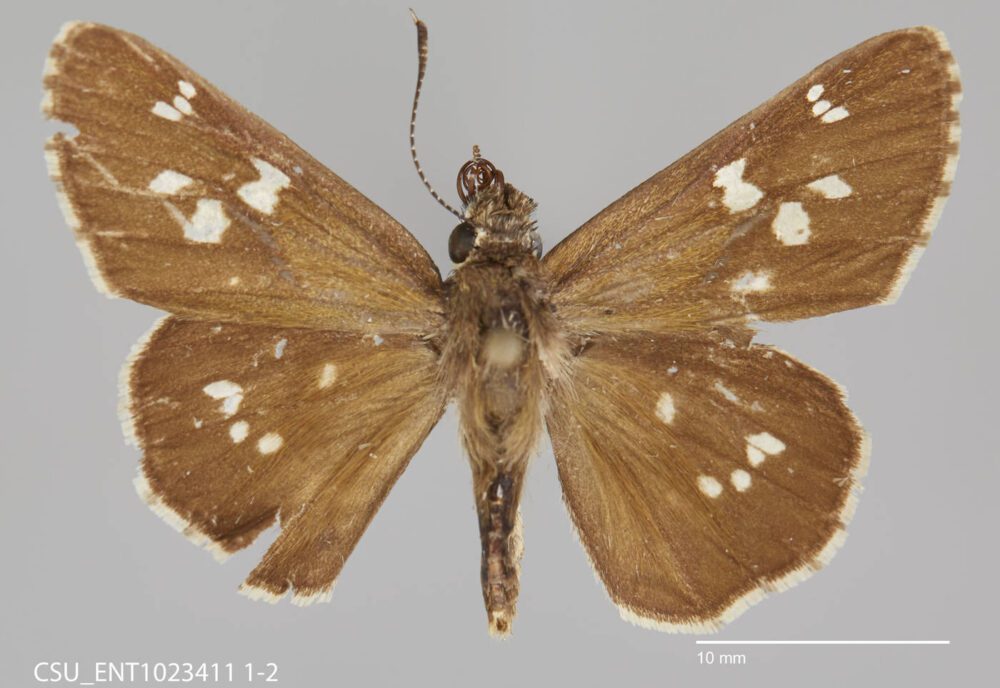by Steven J. Cary and Michael E. Toliver [This site is under construction.]
Skippers (Hesperiidae). About a third of our butterfly fauna, more than 100 species, belongs to this family, which is subdivided into six subfamilies in the US: Eudaminae, Tagiadinae, Pyrrhopyginae, Pyrginae, Heteropterinae, and Hesperiinae. Of those six subfamilies, five are known from New Mexico and the sixth (Tagiadinae, represented by Celaenorrhinus fritzgaertneri) has been taken on the Arizona side of Cottonwood Canyon, Peloncillo Mountains. Therefore, it is likely that eventually all six will be known from our state. The tribe Megathymini had until recently been considered a seventh subfamily, but genetics work by Li, et al. (2019) shows it belongs within the Hesperiinae. Skippers earned their name because of their rapid, skipping flight, which is powered by a heavily-muscled thorax. All skippers have antennal clubs that are distinctively bent, curved or hooked. Larvae silk leaves together for nests; larvae overwinter. Most subfamilies have characteristic larval food preferences. Updated November 30, 2022.
Grass Skippers (Hesperiidae: Hesperiinae). This present section VI-A describes about two-thirds of our 50+ known Grass Skippers species. The vast majority are small, with wingspans of 1.5 inches or less, and with subtle marks. Some genera contain many similar species that pose challenges for identification. Adults typically rest with wings folded together over the back. When active, most perch with hindwings spread horizontally and forewings cocked half open, which is a challenge for photographers. Most Hesperiine larvae eat grasses and therefore are most prevalent in prairies, savannas and mountain meadows. The number and diversity of Grass Skippers in any particular location generally speaks to the health of grassland ecosystems.
Branded Grass Skippers (Hesperiidae:Hesperiinae:Hesperiini). There are too many species of Grass Skippers to fit comfortably onto one PEEC webpage, so in this section VI-A we include the first 15 genera, which all belong to Subtribe Hesperiina: Branded Grass Skippers. The remaining six subtribes and nine genera follow in Section VI-B, Other Grass-Skippers (Hesperiidae:Hesperiinae:Hesperiini Moncina, Apaustina, Thymelicina, Calpodina. Updated October 16, 2025
- Kiowah Skipper (Euphyes kiowah) Dun Skipper, Euphyes vestris, immaculatus
- Simius Roadside-Skipper (Notamblyscirtes simius)
- Durango Roadside-Skipper (Notambyscirtes durango seaza)
- Delaware Skipper (Anatrytone logan lagus)
- Common Mellana (Quasimellana eulogius)
- Fiery Skipper (Hylephila phyleus)
- Crossline Skipper (Limochores origenes rhena) Polites origenes
- Long Dash (Limochores mystic ) dacotah, nino, Polites mystic
- Tawny-Edged Skipper (Polites themistocles)
- Sandhill Skipper (Polites sabuleti) alkaliensis, ministigma
- Draco Skipper (Polites draco)
- Peck’s Skipper (Polites coras surllano)
- Rhesus Skipper (Yvretta rhesus) Polites rhesus
- Carus Skipper (Yvretta carus) Polites carus
- Huron Sachem (Atalopedes huron) Atalopedes campestris
- Western Branded-Skipper (Hesperia colorado) Hesperia comma, susanae
- Juba Skipper (Hesperia juba)
- Nevada Skipper (Hesperia nevada)
- Apache Skipper (Hesperia woodgatei)
- Uncas Skipper (Hesperia uncas) Hesperia uncas lasus
- Pahaska Skipper (Hesperia pahaska) williamsi
- Green Skipper (Hesperia viridis)
- Rocky Mountain Woodland Skipper (Ochlodes napa) Ochlodes sylvanoides,Ochlodes napa kaibab
- Yuma Skipper (Ochlodes yuma anasazi)
- Morrison’s Skipper (Stinga morrisoni)
- Hobomok Skipper (Lon hobomok wetona) Poanes
- Taxiles Skipper (Lon taxiles) Poanes, Lon zabulon
- Umber Skipper (Lon melane vitellina) Poanes, Paratrytone
- Snow’s Skipper (Paratrytone snowi) Ochlodes
- Dusted Skipper (Atrytonopsis hianna turneri)
- Deva Skipper (Atrytonopsis deva)
- Moon-Marked Skipper (Atrytonopsis lunus)
- Viereck’s Skipper (Atrytonopsis vierecki)
- White-Barred Skipper (Atrytonopsis pittacus)
- Margarita Skipper (Atrytonopsis margarita)
- Python Skipper (Atrytonopsis python)
- Sheep Skipper (Atrytonopsis edwardsi)
Euphyes kiowah (Reakirt 1866) Kiowah Skipper (updated November 30, 2023)
Description. Kiowah Skipper is dark brown on all wing surfaces. Males have a black stigma. Females have a row of vague postmedian white spots on the forewing above and below. Gold scales cover the palps and heads of fresh individuals. Range and Habitat. The range of Euphyes kiowah extends from Colorado into AZ, TX and Mexico, including much of NM, where it occupies Upper Sonoran and Transition Zone habitats (counties: Be,Ca,Co,Ed,Gr,Ha,Li,LA,Mo,Ot,RA,Sv,SJ,SM,SF,So,Ta,To,Un). Its altitudinal range here is broad, 4600 to 9200′, and includes mountains, foothills, prairies and canyon-mesa country. Life History. Larvae are partial to sedges (Cyperaceae). Scott (1992) documented larval use of Carex pennsylvanica heliophila, Carex geophila and Carex rossii in Colorado and it is reasonable to extrapolate those preferences into New Mexico. Half-grown larvae hibernate over winter. Flight. Our records indicate one extended generation per year. Extreme dates are May 15 and August 30 with peak adult numbers in July. The best place to find adults is at flowers near watercourses. Comments. Long treated as a subspecies of the more widespread Euphyes vestris (Boisduval 1852), Euphyes kiowah was at long last recognized by Zhang et al. (2022b) and affirmed by Zhang et al. (Oct. 2023) as a distinct species. Form immaculatus (R. Williams 1914), now synonymized, was described from specimens collected by John Woodgate in the Jemez Mountains.




Notamblyscirtes simius (W. H. Edwards 1881) Simius Skipper (updated January 22, 2023)
Description. Simius Skipper has spot patterns typical of the genus Amblyscirtes, plus a pale spot in the dorsal forewing cell. Above, the ground color can be either rusty dark orange (form rufa) or mostly black (form nigra). Beneath, it has a pale gray hindwing and pale tawny forewing. Hindwing fringes are unchecked white. The similar Durango Skipper is much darker ventrally (Gr, Hi). Range and Habitat. This unique species lives in shortgrass prairies and savannas from Canada south to Arizona, Texas and Mexico. Never common, it is widespread across New Mexico (counties: Be,Ca,Ch,Ci?,Co,Cu,DA,Ed,Gu,Ha,Li,LA,Mo,Ot,RA,Sv,SM,SF,So,Un,Va?), usually 4500 to 7500′ elevation, but straying up to 9000′. Life History. A female oviposited on Bouteloua gracilis (Poaceae) near the Canadian River (Mo) on 3 July 1987 (S. Cary). This widespread shortgrass prairie plant is used elsewhere and may be the sole larval host plant. First stage larvae hibernate. Flight. Notamblyscirtes simius is univoltine, but flight time varies to coincide with and capitalize on the local rainy season. Peak flight is in June on our northeast plains, June – July in north-central New Mexico, and July – August in southern New Mexico. Extreme dates are April 20 and August 29, suggesting the possibility of two flights in wet years. Males hilltop; both sexes come to nectar. Comments. Due to superficial similarities of size, wing shape and basic markings, Simius was long treated as a member of the genus Amblyscirtes.






Notamblyscirtes durango J. A. Scott 2017 Durango Skipper (updated November 30, 2023)
Description. Durango Skipper has spot patterns typical of the genus Amblyscirtes, with an added pale spot in the dorsal forewing cell. It resembles Simius Skipper (it was originally described as a subspecies of Simius) but is much darker. Beneath, it has a brownish hindwing and forewing, though the forewing has some tawny coloration near the lower margin. Hindwing fringes are unchecked white. Range and Habitat. Durango is found primarily in Mexico, but its range extends north into Arizona and New Mexico. In New Mexico, it is found in our SW counties (Gr,Hi). Life History. Bouteloua gracilis (Poaceae) is believed to be the host plant for Durango, as it is for Simius. First stage larvae hibernate. Flight. Notamblyscirtes durango is univoltine, but flight time may vary to coincide with and capitalize on the local rainy season. It flies in July – August. Both sexes come to nectar. Comments. Recently separated as a full species from Simius by Zhang, et. al. (2022), it certainly has a distinct appearance. Our populations differ genetically from that farther south in Mexico and have been given the subspecific epithet seaza Grishin (Zhang et al., Nov. 2024).



Anatrytone logan (W. H. Edwards 1863) Delaware Skipper (updated January 8, 2023)
Description. Delaware Skipper is distinctive because of its medium size (for a skipper), habitat (eastern plains near watercourses) and its immaculate, soft gold underside. The only other NM species that approaches Delaware in appearance is the very rare Common Melana, known only from a single specimen captured in Doña Ana County. Delaware can be separated from male Common Melana by the lack of a dark streak on the FW above the lower margin. Also note Delaware’s distinctive black edging and black veins toward the margin of the forewing upperside. Range and Habitat. An eastern US species, Anatrytone logan is distributed west to the Rocky Mountain Front Range and from Canada south to west Texas. It occupies Upper Sonoran Zone prairies and stream corridors. In New Mexico it makes its home in our Eastern Plains (counties: Ch,Co,Cu,DB,Ed,Gu,Ha,Li,Mo,Qu,Ro,SM,Un). Life History. Larvae eat tall, broadleaf grasses like Bromus inermis. Flight. Anatrytone logan has one flight per year peaking in June and July, with extreme dates of May 16 to August 9. Records from August 26 to October 2 suggest a partial second brood in southeastern New Mexico. Adults come to nectar, especially thistles, and water. Comments. Our populations belong to western subspecies Anatrytone logan lagus (W. H. Edwards 1881). Our oldest report of Delaware Skipper was from 27 June 1969 near Conchas Dam (SM) by Richard Holland. Until about 1985 this species was thought to be merely a stray in New Mexico, which shows how little-studied our Eastern Plains butterflies were until recently.




Quasimellana eulogius (Plӧtz 1882) Common Mellana (updated January 31, 2022)
Description. This skipper resembles a number of other folded-wings skippers, which complicates our understanding of its true status north of the border. In NM it is distinguished from most similarly sized (a little over 1 inch wingspan) folded-wing skippers by its relatively plain orange-gold ventral HW, with a faint row of median spots. The upperside of the male resembles the female Delaware skipper, but male Common Mellana have a dark streak on the FW above the lower margin that extends from the base to the margin. Females are much darker dorsally, somewhat resembling female Sachem. Range and Habitat. Common Mellana is not common north of the border! It does occur regularly in S TX but otherwise is extremely rare elsewhere in the US. Its normal range is Mexico south to Brazil. Life History. This species has been reared from eggs in south TX. Flight. In south TX, the species is recorded from most months of the year. Our single record is from August. Comments. On August 8, 2005, Paul Opler collected this small, orange skipper as it visited Wright’s Buckwheat (Eriogonum wrightii) on San Augustin Pass northeast of Las Cruces, in Dona Ana County. Dr. Opler’s opportune capture is our sole report of Common Mellana from New Mexico. Considering the array of small, orange, folded-wing skippers, Mellana might be more frequent, and simply overlooked. Nevertheless, until we have more sightings, it is best considered a very rare stray associated with late summer rains. Opler’s specimen is now at the C. P. Gillette Museum of Arthropod Diversity at Colorado State University in Fort Collins (see image below).






Hylephila phyleus Fiery Skipper (updated January 14, 2023)
Description. Fiery Skippers resemble Sachem and some Polites species. Males are gold above with a bold, black stigma and distinctive, jagged black borders. Below, males are two-toned gold with a unique pattern of black dots. Females have a ventral hindwing pale post-median band that is bordered outwardly with a more prominent repeat of the black dots found on the male. Range and Habitat. Hylephila phyleus is a subtropical insect that ranges from South America north to the southern US. In New Mexico it occurs below 5500’ elevation in cities and other disturbed areas (counties: Be,Ch,Ca,Cu,DB,DA,Ed,Gr,Hi,Le,Lu?,Ot,Ro,Sv,SF,Si,So,Va). Life History. Larval hosts are a variety of grasses (Poaceae), including popular lawn and athletic field species such as Bermuda grass (Cynodon dactylon). Flight. Our records begin March 22 and go to November 26. Hylephila phyleus seems continuously brooded and becomes increasingly common as the warm season progresses, peaking in September. It probably can be found almost year-round in southern cities like Las Cruces or Hobbs. Adults avidly seek nectar. Comments. Fiery Skipper was discovered in New Mexico in 1956, when it was collected in Albuquerque by the young Mike Toliver. Mike says: it was common then, indicating it had already been present for some time previously. It was first noted in Las Cruces in 1961. It probably came in with introduced lawn grasses.






Limochores mystic (W. H. Edwards 1863) Long Dash (added January 17, 2023)
Description. This species gets its common name from the distinctive male stigma, which is long and connected to an elongated spot at the end of the FW cell – creating a “long dash.” The female is largely brown above, with patches of ochre spots. Beneath, both sexes are mostly brownish yellow, with a pale postmedian curved band of light, yellow spots on the HW, varying in intensity. Range and Habitat. Long Dash is largely northern in distribution, found from British Columbia and Washington east to Nova Scotia and the mountains of the NE US. It follows mountain uplands at higher altitudes, ranging south to Virginia in the eastern US and to S CO and N AZ in the west. Life History. Females oviposit on various grasses, including Poa species. Flight. If and when it is found/confirmed in our state, it probably will be found to have one annual brood, with peak flight occurring in June and July. Comments. Formerly Polites mystic, Evans (1955) reported this species from New Mexico on the basis of three specimens in the Natural History Museum (London?). It has not been otherwise reported from our state, but its documented occurrence in north-central Arizona and reports from southwest Colorado favor its eventual confirmation from New Mexico when mountains in northwest New Mexico are more thoroughly explored. Zhang et al., Dec. 2023 described the AZ populations as new ssp. Limochores mystic nino Grishin and suggested “Populations in southwestern Colorado should be studied to determine their taxonomic identity.” To which we say, and northwest New Mexico.


Limochores origenes (Fabricius 1793) Crossline Skipper (updated March 9, 2024)
Description. Crossline Skipper is decidedly less widespread, larger and more brightly marked than the similar Tawny-Edged Skipper. Separate it from Tawny-Edged by a narrower stigma on male DFW, as well as less contrast between VHW and leading edge of VFW. VHW often has a more obvious spot band. Postmedian white spots decorate all wing surfaces, but hindwing spots may be faint. Females have very little orange above. Range and Habitat. This eastern US butterfly bridges the Great Plains with colonies sprinkled from North Dakota south to northeastern New Mexico (counties: Co,Li?,SM,Un), where it has become rather scarce of late. Low Transition Zone grasslands from 5500 to 8000’ support this scarce skipper. Life History. Grasses (Poaceae) are larval hosts throughout its range. Big bluestem (Andropogon gerardii) is the chief host in the Front Range, with occasional use of sideoats grama (Bouteloua curtipendula) and Panicum oligosanthe. Larvae make above-ground grass nests and overwinter. Flight. Limochores origenes has one annual generation that flies from June 21 to July 21. Adults fly in grassy swales. Males perch on prominent vegetation. Comments. Kansas Professor F. H. Snow collected our oldest specimens of this species near Las Vegas (SM) in 1882. Our populations belong to western Limochores origenes rhena (W. H. Edwards 18878). Crossline Skipper resided in the genus Polites for many years. Zhang et al. (2021) moved it to Limochores based on DNA studies, but other experts dispute the wisdom of this shift. We follow Zhang et al. here, while acknowledging the ongoing conversation.





Polites themistocles (Latreille [1824]) Tawny-Edged Skipper (updated January 15, 2023)
Description. Tawny-Edged Skipper is uniform green-gold below, at times with a ghost of a pale hindwing postmedian band. Above, it is brown with an orange tawny patch behind the forewing costa, which gives this species its common name; males have a black stigma. There are 1 (in males) to 3 (in females) pale postmedian spots on the forewing above. Range and Habitat. Polites themistocles occurs across much of eastern North America from Florida to southeast Canada, then west to British Columbia and south to Arizona and New Mexico (counties: Ca,Ci,Co,Li,LA,MK,Mo,Ot,RA,Sv,SJ,SM,SF,Ta,Un). In our area it lives in Transition and Canadian Zone meadows, usually 6700 to 10,000′ elevation. Life History. Larvae eat various grasses, including some species found in urban lawns. Koeleria macrantha probably is our primary host. Flight. Our adult observations span May 12 to September 9, peaking in June and July. This may represent one generation at high elevation and two at lower sites. Look for adults at nectar and wet sand. Comments. The population in the Sacramento Mountains needs closer examination due to the occasional appearance of completely dark females, like those of Polites origenes. There are a number of high mountain ranges (e.g., the Sandias and Manzanos) which curiously lack records of this otherwise-widespread, mountain-meadow species.





Polites sabuleti (Boisduval) Sandhill Skipper (updated March 18, 2023)
Description. Sandhill Skipper and the next species have black dots near ventral vein-ends. Polites sabuleti has a lighter, less grizzled, color below and veins are white. Males are yellower above than Draco, especially on the veins. Range and Habitat. This Great Basin insect ranges north to British Columbia, south to Baja California, west to coastal California and east to the central Rockies. It inhabits Upper Sonoran to Transition Zone grasslands. In New Mexico it finds livable conditions in our northwest quadrant (counties: Co?,RA,Sv,SJ,SM?,SF,Ta), 5000 to 8000′ elevation. Life History. Larvae eat various grasses (Poaceae) as hosts. Distichlis spicata var. stricta, Hordeum jubatum, Puccinellia distans, Poa arida and Sporobolus airoides are documented in the literature. The latter species is the principal host along the Rio Grande near Pilar (RA,Ta). Sandhill Skippers also colonize introduced grasses such as Poa pratensis (SJ,SF). Flight. Records for New Mexico indicate two brief generations per year: May 26 to June 26 and again August 18 to October 14. There are no July reports. Adults perch in gullies, swales and along river floodplains. Comments. Our populations may belong to a couple different subspecies. Polites sabuleti alkaliensis Austin, 1987, was described from Nevada, but is listed on the Butterflies of America web site (https://www.butterfliesofamerica.com/US-Can-Cat.htm) as ranging from SE WA to NW NM. It may be the subspecies present in San Juan County. Polites sabuleti ministigma J. Scott, 1981, was described from south central CO (the San Luis Valley) and is likely the subspecies found in north-central NM (Co?,RA,SM?,SF,Sv,Ta).





Polites draco (W. H. Edwards) Draco Skipper (updated January 19, 2023)
Description. Compared to Polites sabuleti, Polites draco has similar markings but with greater contrast between cream-colored light spots and the dark, green-brown background on the hindwing below. Unlike on P. sabuleti, pale marks on the draco VHW are blocky and rounded. Range and Habitat. This montane species occurs throughout the Rocky Mountains. In New Mexico it is widespread in high-elevation Canadian Zone and higher grasslands and savannas, 8000 – 12,000′ (counties: Ci,Co,LA,MK,Mo,RA,Sv,SM,SF,So,Ta). The southernmost known colony of Draco Skipper was found on South Baldy, Magdalena Mountains (So) by D. Cowper. Draco has not been seen there in recent years. Life History. Females oviposit on various grasses or nearby plants, apparently seeking out Festuca idahoensis, Festuca arizonica, Poa pratensis and Koeleria macrantha, among others. Winter is passed in the larval stage. Flight. Draco Skippers are on the wing in one generation each year, generally from May 19 to August 27, with peak numbers in late June and July. Adults are seen at mud, at nectar or perching on rocks and fallen trees in grassy alpine meadows. Comments. Some authorities point to intermediate forms and suggest that Draco Skipper and Sandhill Skipper may be altitudinal variants of one species, rather than two distinct species.





Polites coras (Cramer 1775) Peck’s Skipper (added February 17, 2023)
Description. Similar to Sandhill and Draco skippers, but distinguishable from them by the ventral hind wing, which has a distinctive “anchor” pattern of the enlarged postmedian band of pale spots and a “shank” of basal spots. Dorsally, both males and females tend to be darker than either Sandhill or Draco skippers. Range and Habitat. This is primarily an eastern species, occurring from Texas and Georgia north into southern Canada. There are disjunct populations in NW US (Washington, Idaho, Montana, Wyoming), northern and central Colorado, and surprisingly, eastern Arizona. In the East, this species is a common “lawn” skipper. It inhabits many open grassy areas throughout its range. Life History. Larvae feed on a variety of grasses. Toliver has observed oviposition on at least two different lawn grasses (including Poa) in his yard in Illinois. Flight. There are two to three generations annually, with adults apparent from May through at least October. Comments. This skipper has a curiously disjunct distribution. It is predominantly an eastern US species, but recently it has been found in northern and central CO and in eastern AZ. It occurs in the White Mountains of Apache Co., AZ within 20 miles of NM, and should be looked for in high wet spots in western Catron County. Scott (2006) described the western populations as a distinct subspecies, Polites coras surllano J. Scott 2006.




Yvretta rhesus (W. H. Edwards 1878) Rhesus Skipper (January 21, 2023)




Yvretta carus (W. H. Edwards 1883) Carus Skipper (updated January 22, 2023)
Description. Carus Skipper can be confused with Rhesus, but it is somewhat smaller and wing fringes are gray. Like Rhesus, it is gray/black above with white spots, while the similar Uncas Skipper has orange highlights above. The ventral hindwing network of white-scaled veins is denser than on Rhesus and it is set against a predominantly gold/tan background with fewer (if any) “Uncas-like” or “Rhesus-like” dark patches. Range and Habitat. The range of this Central American and Mexican species extends north into southern California, southern Arizona, west Texas and southern New Mexico (counties: Be,Ca,DA,Co,Ed,Gr,Ha,Hi,Li?,Qu,Ro,Si). Look for it in grasslands, 4600 to 7500′ elevation. Life History. Brock (1993) reported multiple ovipositions on Muhlenbergia rigens (Poaceae) in southeast Arizona and probably in southern New Mexico as well. Jim says follow-up work has been difficult because larvae are subterranean! Flight. Yvretta carus is double brooded in southern New Mexico, flying from April 11 to June 27 and again from July 19 to August 20. Records from farther north fall within the span of April 30 to July 27, suggesting one extended generation. Some male hilltopping has been noted. Adults come to mud and nectar (e.g., Asclepias, Glandularia). Comments. This skipper is not frequently encountered in most of New Mexico and as a result its life cycle and ecology here remain poorly understood. A seasonal form has ventral colors of gold tending to orange, and the forewing is more pointed. We follow some experts and place Rhesus and Carus within the genus Yvretta, but some authorities reduce Yvretta to a subgenus of Polites.





Atalopedes huron (W. H. Edwards 1863) Huron Sachem (updated January 25, 2023)
Description. Misidentifications are common for this sexually dimorphic species. Huron Sachem males have a huge black stigma. The ventral hindwing is tan to brown with pale bands paralleling the veins. Females resemble the various Hesperia species, but with a black patch beneath the dorsal forewing cell and the postmedian spot band on the ventral hindwing is usually less prominent. Range and Habitat. Atalopedes huron breeds from South America northward into the US, straying as far as southern Canada. In New Mexico it is widespread at low or moderate altitudes (all counties except Ci,LA,MK,RA,Ta,Va). Life History. Larvae eat grasses (Poaceae) such as Distichlis species, Cynodon dactylon, Festuca rubra, Stenotaphrum secundatum, Digitaria sanguinalis, Eleusine indica and Poa pratensis. Huron Sachem breeds at least seasonally in our southern and eastern counties, occurring farther north only as a stray. Flight. Huron Sachem is bivoltine in New Mexico. Extreme dates are April 22 and November 28, peaking in June to July and again in September. It is most common in late summer, though rarely seen in large numbers. Adults are often found at nectar. Comments. Atalopedes huron, previously considered a subspecies of Atalopedes campestris, was raised to full species status by Zhang, et. al. (2022). It is best distinguished from Sachem (restricted to the far West from Baja California to western Idaho) by locality. Our oldest record is a specimen in the New Mexico Highlands University collection taken 17 miles southeast of Las Vegas (SM) on 8 June 1946.







Hesperia colorado (Scudder 1874) American Branded-Skipper (updated March 17, 2023)
Description. The genus Hesperia has many representatives in North America. All are small with orange and brown marks above and with white spots on a green-gold underside. American (formerly Western) Branded-Skipper can be reliably distinguished from other New Mexico Hesperia species using a combination of its late flight period, its preference for high altitude, and the elongated white “C” spot in the cell of the hindwing below. Range and Habitat. Hesperia colorado lives in most western North American cordillera. It is a montane species in New Mexico, preferring Transition and Canadian Zone meadows and savannas between 7500 and 10,000′ elevation. Life History. Scott (1992) gave important Colorado larval hosts as Carex foenea and Carex pennsylvanica (both Cyperaceae), as well as Bouteloua gracilis, Bouteloua curtipendula, Bromus tectorum and Andropogon scoparius (all Poaceae). A female oviposited on Poa interior on 23 Aug 2003 (RA). Eggs hibernate over winter. Flight. Western Branded-Skipper is a late summer flyer with greatest numbers in August. Extreme dates are June 14 and September 22, but reports before late July are suspect. Adults come eagerly to nectar. Males patrol topographic high spots. Comments. This butterfly is part of a complex once grouped under Old World Hesperia comma (Linnaeus 1758), in which much research is still needed. Currently, we think north-central New Mexico (counties: Co,LA,Mo,RA,Sv,SM,Ta,Un) harbors H. colorado idaho, but nascent DNA work may have something to say about that. Western New Mexico (counties: Ca,Ci,Gr,MK,SJ) adults have smaller ventral white marks and are subspecies Hesperia colorado susanae L. Miller 1962.


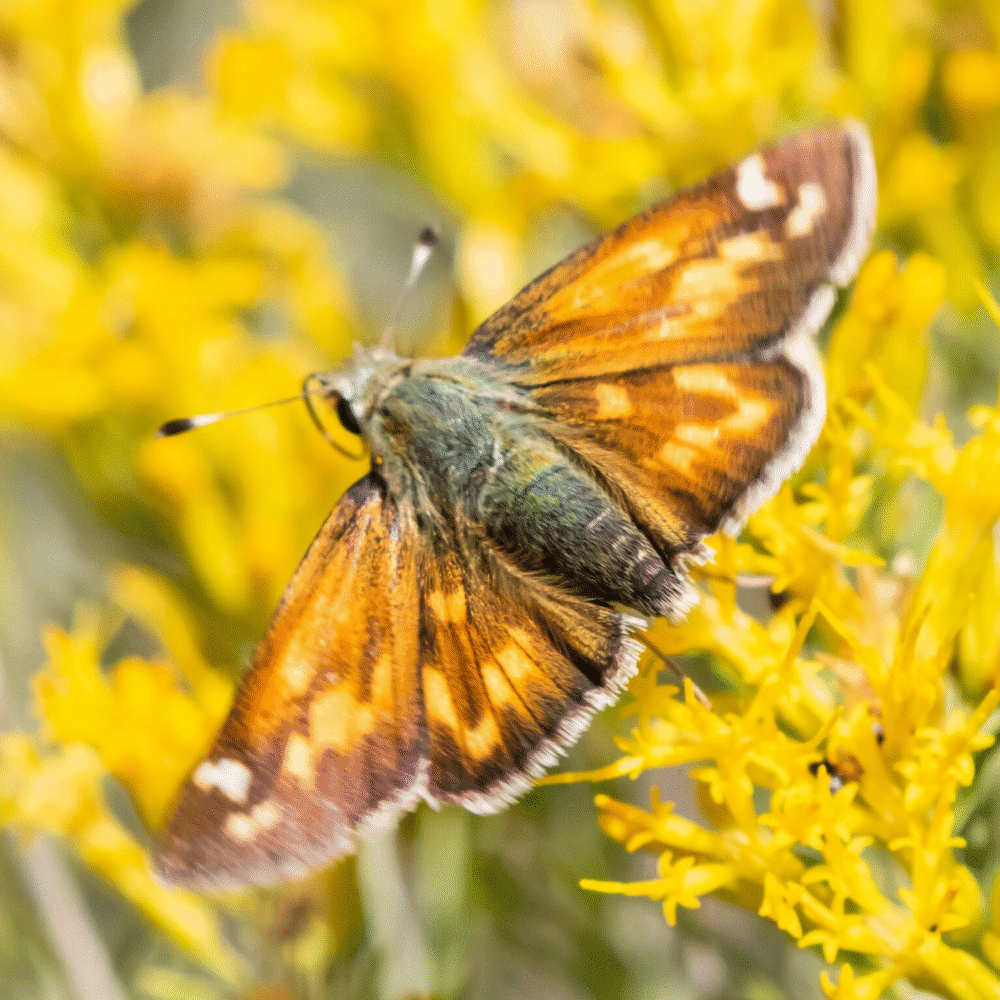


Hesperia juba (Scudder 1874) Juba Skipper (January 31, 2023)
Description. Juba Skipper is our largest Hesperia species, rivaled only by autumn-flying Hesperia woodgatei. Juba has shorter antennae, larger apiculus(es), and larger ventral hindwing white spots. A jagged dark border on the forewing upperside contrasts with the orange median area, unlike Hesperia nevada. The underside ground color is green and the last white spot on the ventral postmedian band is offset inward. Range and Habitat. This is a Great Basin bug whose larger distribution extends to California and to British Columbia. It lives in Upper Sonoran to Transition Zone savannas and sage flats, 5000 to 9000′ elevation. Hesperia juba enters northwest New Mexico in the foothills of the Chuska and Jemez Mountains and near Chama (counties: RA,Sv,SJ). Life History. According to Scott (1992), spring females oviposit on Poa species, Agropyron species, Stipa comata and Bouteloua gracilis (all Poaceae), while autumn-flying females choose different grasses: Poa secunda var. sandbergii, Bromus tectorum and Bouteloua gracilis. Young larvae overwinter. Flight. Juba is bivoltine. The spring brood flies May 12 to June 19, while our few second-brood records span August 28 to September 9. Males perch and patrol in gully bottoms. Comments. An 1882 report of Hesperia juba by F. H. Snow from Las Vegas (SM) was examined by W. H. Edwards and determined to be a new species: Hesperia viridis. Snow’s specimen is the type.


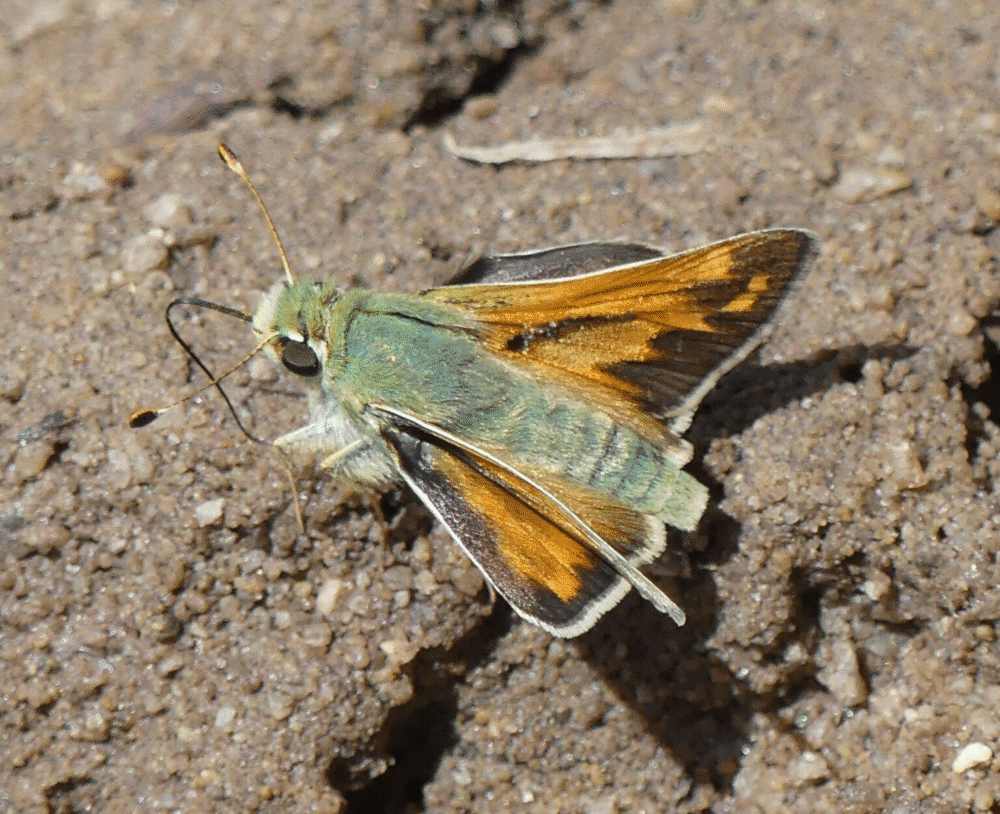
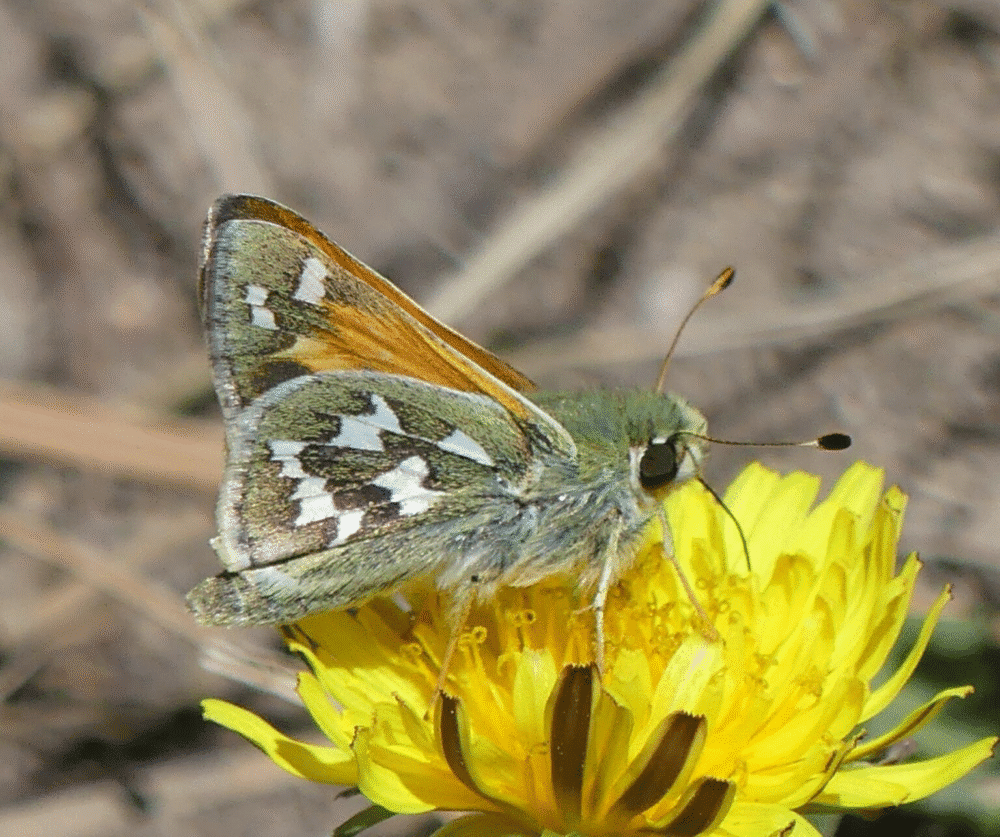

Hesperia nevada (Scudder 1874) Nevada Skipper (updated January 31, 2023)
Description. Nevada Skipper has a gray-green underside, wearing to olive-brown. On the arc of white spots on the ventral hindwing, the bottom white spot is shifted markedly inward. Brown margins on the forewing above blend smoothly into the fulvous postmedian area. Range and Habitat. In New Mexico, no other Hesperia sp. flies at higher elevations. Western Branded-Skipper comes close (and does fly above timberline in central Colorado), but Nevada flies well before Western Branded. Hesperia nevada occupies grasslands dry meadows in Canadian Zone areas and higher (8000 to 11,500′) in northern New Mexico (counties: Co,Mo,LA,RA,Sv,SM,SF,Ta). Colonies are scattered throughout montane western US and southwest Canada. Life History. Larval host grasses (Poaceae) in New Mexico include Koeleria macrantha, Festuca idahoensis, Festuca ovinia, Stipa comata, Bouteloua gracilis, Poa pratensis and Danthonia parryi (Ferris and Brown 1980, Scott 1992). Larvae overwinter. Flight. Nevada Skipper is univoltine throughout its range. New Mexico adults are observed between May 24 and August 12, usually June – July. Look for them at nectar and moist earth in mountain meadows. Comments. This insect was first reported in New Mexico by T. D. A. Cockerell, who found it near Spring Mountain west of Las Vegas (SM), during 1-4 August 1900. The nominate race flies in New Mexico.




Hesperia woodgatei (R. Williams 1914) Apache Skipper (updated January 31, 2023)
Description. Apache Skipper has a ventral hindwing that is dark green-brown with widely spaced smallish white spots. It is larger than most congeners. Distinctively, antennae are very long with white at the base of the club and with a rather small apiculus. These features separate it from late-flying Pahaska, Juba and Western Branded skippers. Range and Habitat. Hesperia woodgatei occurs discontinuously in uplands from central Mexico north along the Sierra Madre to central Arizona, New Mexico, west Texas and up into extreme southern Colorado. In New Mexico it inhabits Transition Zone savannas, 6500 to 8400′ elevation (counties: Be,Ca,Ed,Gr,LA,MK,Mo,Ot,RA,Sv,SM,SF,Si,So,Ta). Life History. Larval hosts are unknown grasses (Poaceae). Flight. Adults emerge later in the season than most univoltine species, flying from August 30 to October 29. Flight begins earliest in north-central New Mexico and progressively later to the south, perhaps triggered by autumn cold. Males hilltop, occasionally quarreling with final-brood Hesperia pahaska males. Adults nectar and come to water. Comments. The name honors John Woodgate, who collected the types in the Jemez Mountains (possibly Jemez Springs), 10-21 September 1913. Individuals from SE NM (Ed) may represent an undescribed subspecies.




Hesperia uncas W. H. Edwards 1863 Uncas Skipper (updated June 25, 2023)
Description. Within the genus Hesperia, distinguish Uncas Skipper by the white scales coating the hindwing veins below, creating a white spiderweb against a pale green and dark chocolate brown background. Uncas is easily confused with Rhesus Skipper, with which it flies in May, but wings of Uncas are longer and its underside markings, though similar, can be differentiated with practice. Range and Habitat. Uncas inhabits the Great Basin, Rocky Mountains and High Plains where it likes Upper Sonoran and Transition Zone grasslands or savannas. In New Mexico it occurs statewide except not in our southwest corner (all counties except DA,Hi,Lu,Si), usually between 5200 and 9000′ elevation. Life History. Scott (1992) reported oviposition on blue grama grass, Bouteloua gracilis (Poaceae), the preferred larval host throughout its range. Flight. Hesperia uncas is univoltine to trivoltine in New Mexico. Adult flight is at its maximum in July in northern New Mexico, but in May and again July to September in southern New Mexico. Statewide, extreme dates are April 21 and September 23. Avid nectar feeders, adults are particularly fond of thistles. Comments. Eastern and northern New Mexico support the nominate subspecies. Specimens from western and central New Mexico (Ca,Ci,Gr,MK,SJ) have been putatively determined to be subspecies Hesperia uncas lasus (W. H. Edwards 1884), which is more yellow than green ventrally and more orange than gray dorsally. Both lasus and uncas have been recorded from central NM (Be,Sv,So,To,Va).





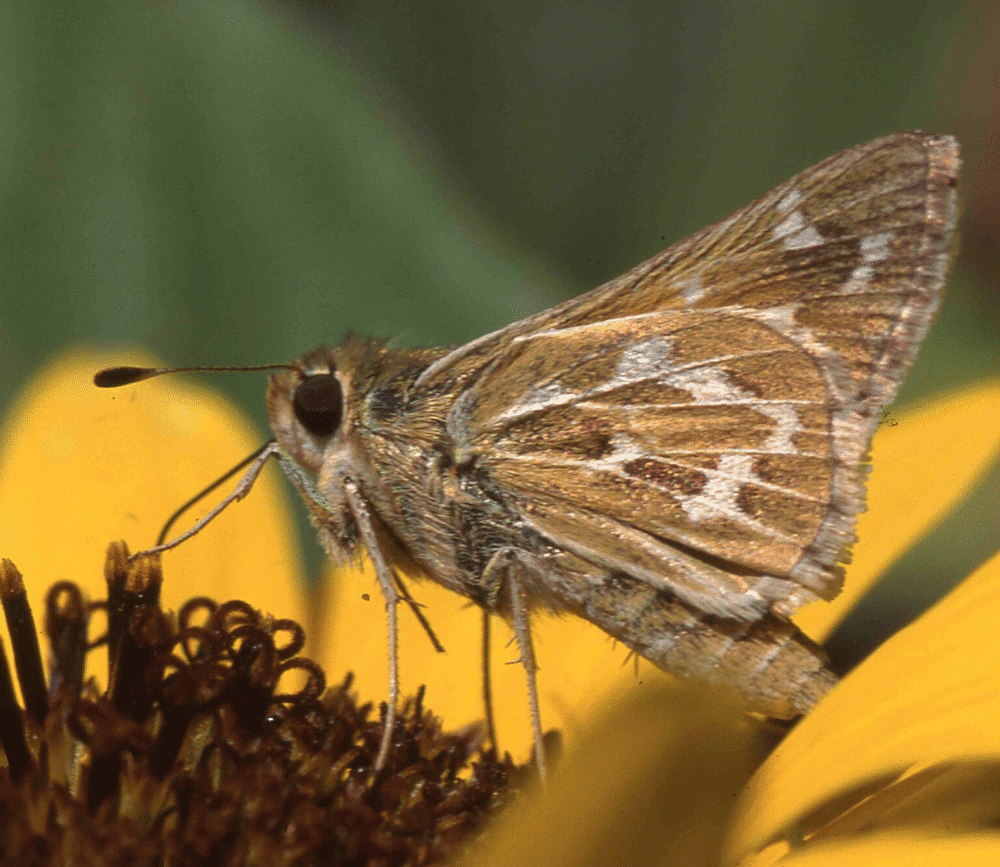



Hesperia pahaska Leussler 1938 Pahaska Skipper (updated December 15, 2023)
Description. Pahaska Skipper is very similar to the Green Skipper, and they often fly together. Distinguishing them from each other is a challenge that cannot always be overcome without specimens to dissect. Your best clues are qualitative and not reliable in all cases. Pahaska’s band of ventral hindwing white spots is either straight at the posterior wing edge or the last spot is shifted inward. Glassberg (2017, pp. 346-347) also points to the two white spots nearest the ventral hindwing apex, which overlap little if at all in Pahaska. If you can net a male, carefully probe the stigma to reveal the androconia, which are yellow for Pahaska. Females may not be visually separable from Hesperia viridis using wing characters alone. Range and Habitat. This western species lives from Mexico north to Saskatchewan and Alberta. It occupies Upper Sonoran and Transition Zone grasslands in most of New Mexico (all counties except DB,Ro), 5000 to 9200′ elevation. Life History. The preferred larval host is blue grama grass, Bouteloua gracilis (Poaceae) Half-grown larvae overwinter. Flight. In northern New Mexico, Pahaska has two annual broods peaking in June and September. In southern New Mexico, Pahaska flies March 28 to November 6, with peak numbers in April, August and October. Males hilltop by perching on the ground and chasing all comers. In the absence of Green Skippers, male Pahaska will patrol gully bottoms. Adults feed at flower nectar. Comments. Most of our populations belong to the nominate subspecies. Southern New Mexico (Ca,Ch,DA,Ed,Gr,Hi,Si) is home to subspecies Hesperia pahaska williamsi. Lindsey 1940, which has smaller ventral HW white spots separated by dark scales. The size of spots on the ventral HW seems to vary a lot throughout the range of Pahaska in NM, to the extent that subspecies boundaries are difficult to map and the best taxonomic placement of individual specimens from Lincoln, Otero and Socorro counties (Li,Ot,So) is unclear. The Capitan Mountains (Li) occasionally produce individuals with an immaculate hindwing below. Zhang et al. Dec. 2023 sequenced an individual from Lincoln County and found it to be nominate H. p. pahaska. Those authors then inferred that H. p. williamsi would be limited to SW NM, but to us that seems like an overly broad conclusion to draw from one sample.
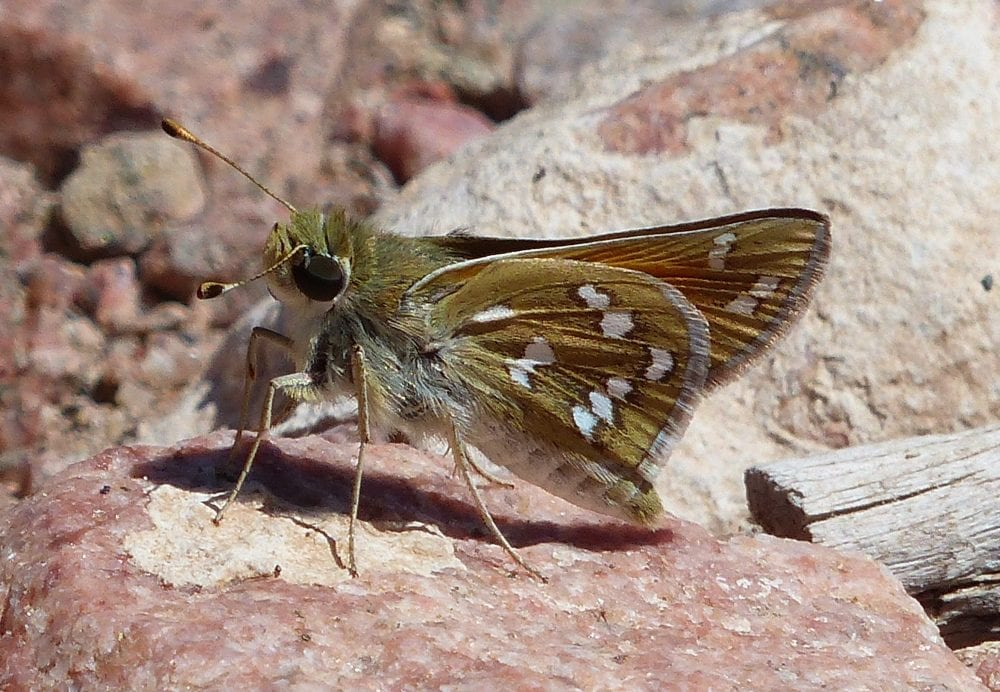

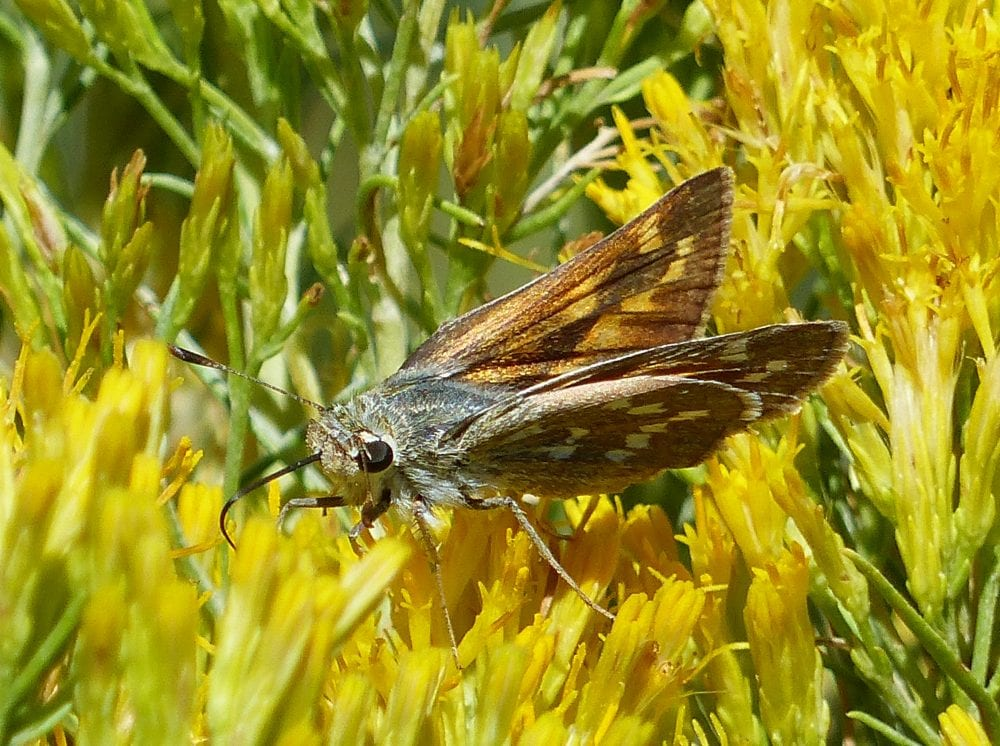
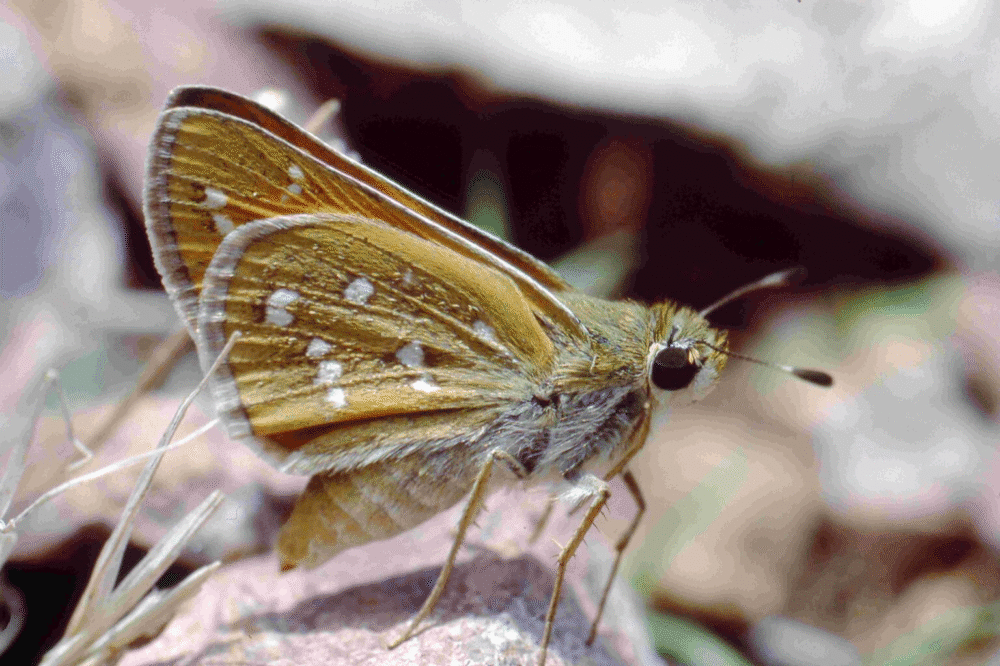
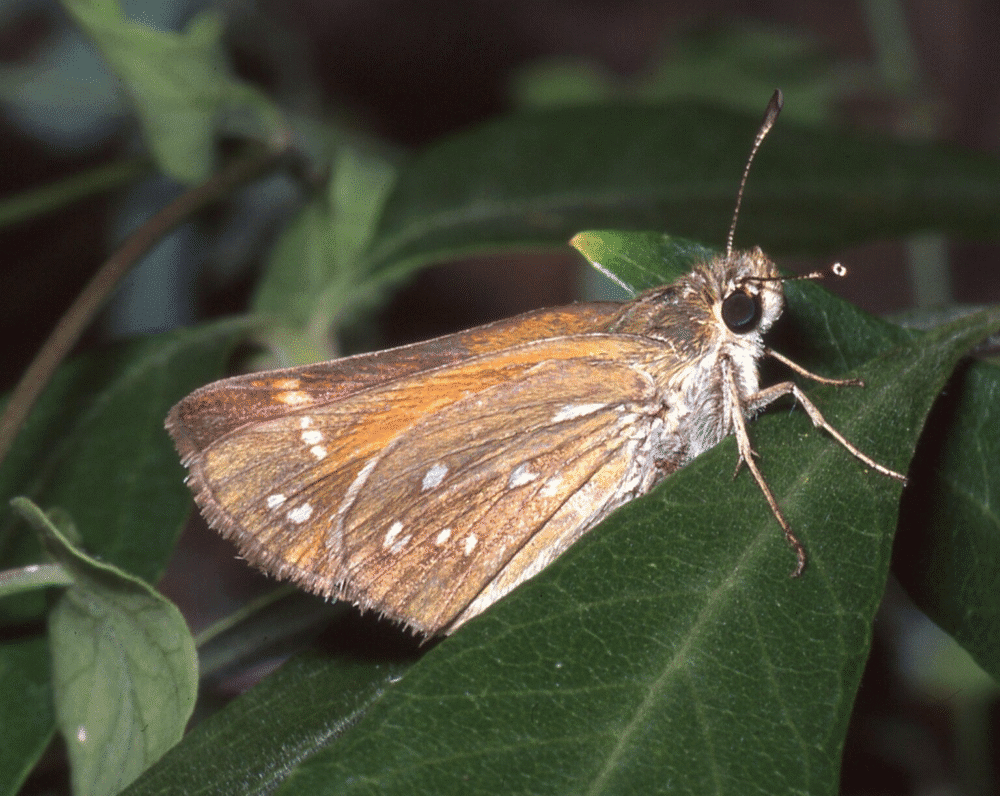

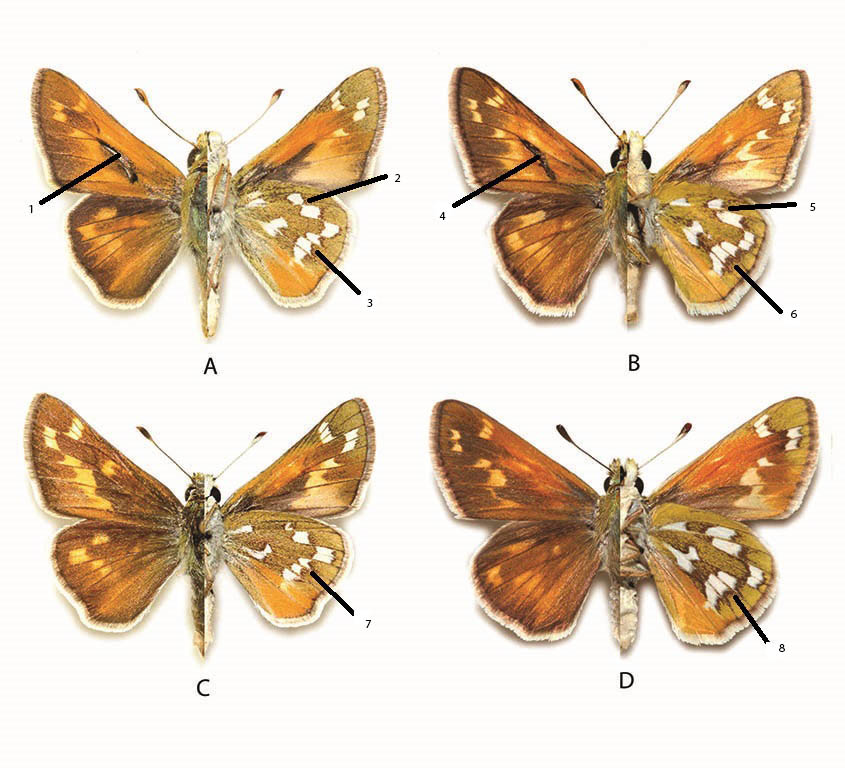
Hesperia viridis (W. H. Edwards) Green Skipper (updated May 5, 2024)
Description. Green Skipper is a virtual look-alike of Pahaska Skipper. The best visual diagnostic character for Green Skipper is the ventral hindwing postmedian band of white spots, where the bottom three spots usually exhibit concavity toward the wing margin. The two white spots nearest the ventral hindwing apex usually show significant overlap. Male androconia are black. Range and Habitat. Hesperia viridis lives on the High Plains from Wyoming and Nebraska south to Texas, Arizona and Mexico. In New Mexico it occupies prairies and savannas from 4500 to 8000′ elevation (all counties except DA,Le,Lu). Life History. Scott (1992) listed Bouteloua gracilis, Bouteloua curtipendula, and Andropogon gerardii as preferred larval hosts in Colorado. Flight. Hesperia viridis has one full and one partial brood in northern New Mexico, flying May 17 to September 9, peaking in June and July. It is bivoltine in southern New Mexico, flying from March 23 to October 2, peaking in May and again July to August. Males patrol vigorously along drainages. Adults come to nectar and moist earth. Comments. Edwards described this species in 1883 from material collected by Kansas Entomology Professor F. H. Snow near Las Vegas (SM). Your topographic position in the landscape can help you decide if you are looking at Green Skipper males or Pahaska Skipper males. If you’re on a hilltop, it’s Pahaska; if in a drainage, probably Green. Females of each can be found almost anywhere in the landscape.

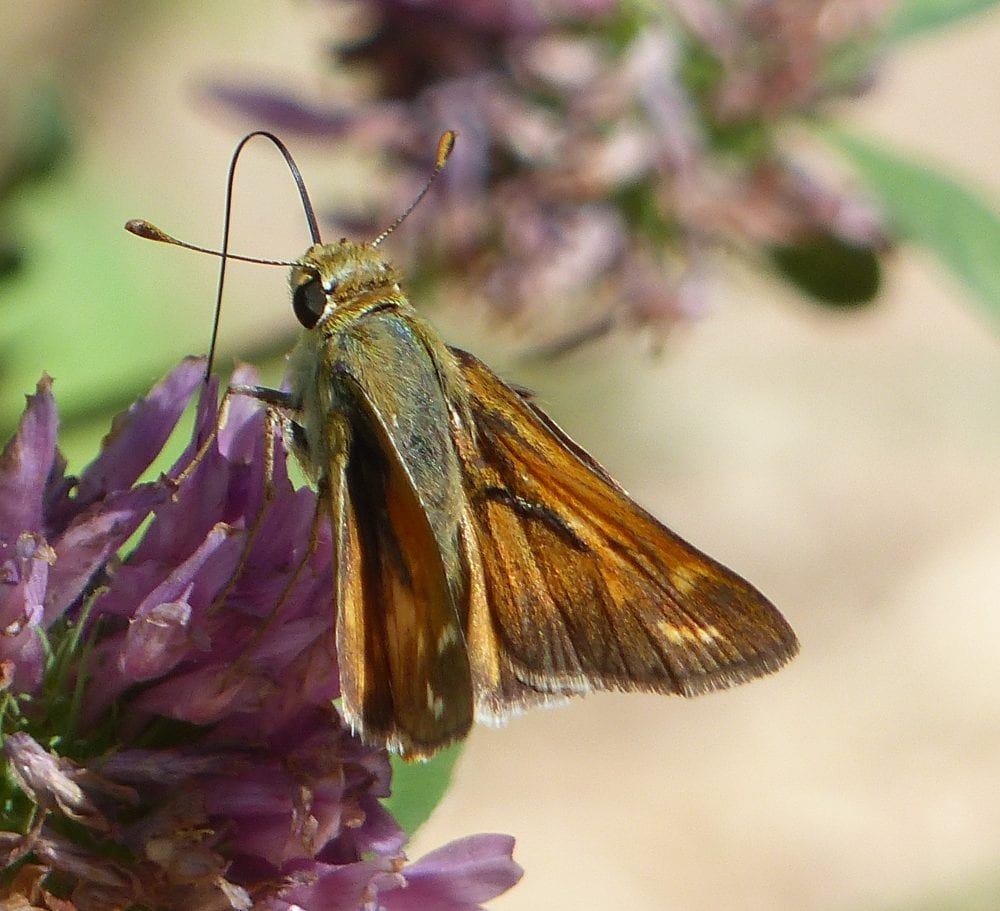

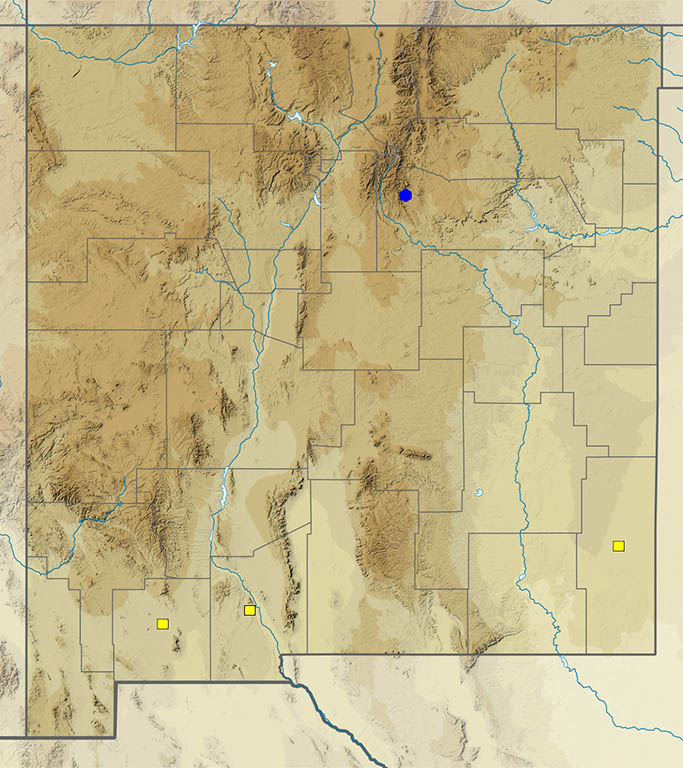
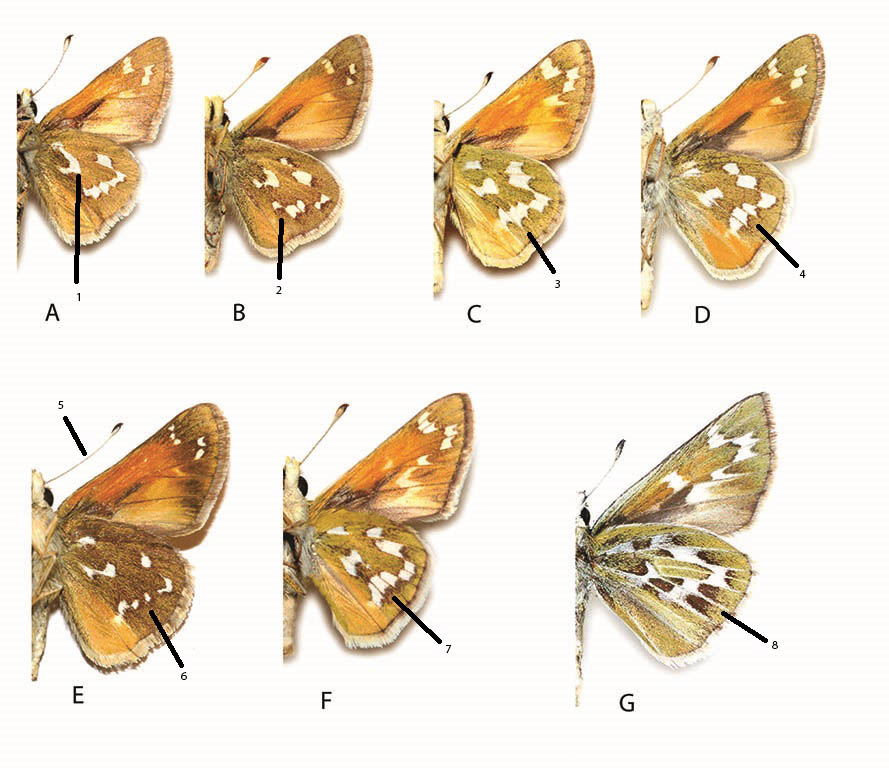
Ochlodes napa (W. H. Edwards 1865) Rocky Mountain Woodland Skipper (updated September 27, 2025)
Description. Rocky Mountain Woodland Skipper is small with a rusty gold hindwing below; its indistinct yellow postmedian band is repeated on the dorsal side. The forewing above has a dark margin with a saw-toothed inner edge. Males have a prominent, dark stigma and post-stigmal patch. Females are similarly marked, but without the stigma, of course. Range and Habitat. Ochlodes napa is distributed from the Colorado Front Range into northern New Mexico. Here, it occurs on the northwest flank of the Jemez Mountains and near Chama (counties: RA,Sv), where it prefers Transition Zone meadows and grassy streamsides, 7000 to 8500′ elevation. Life History. Scott (1992) placed this species in his hay-feeding guild. Likely New Mexico host grasses include these broad-leafed species: Agropyron trachycaulum, Agropyron repens, Bromus inermis, Bromus lanatipes, Dactylis glomerata, Phalaris arundinacea, Phleum pratense and Muhlenbergia racemosa. First instar larvae overwinter. Flight. One broad summer flight extends from June 6 to September 1, focused in July – August. Adults nectar and perch in damp meadows. Comments. We had been treating our populations as O. sylvanoides subspecies napa, but Zhang et al. (12/13/23) proposed that Ochlodes napa is a Rocky Mountain species distinct from West Coast Ochlodes sylvanoides. Further, they described Ochlodes napa kaibab Grishin, new subspecies from Coconino Co., AZ. But all that was done without referring to any New Mexico specimens, but we think it probable that we have the nominate subspecies, O. napa napa.




Ochlodes yuma (W. H. Edwards 1873) Yuma Skipper (updated February 9, 2023)
Description. Yuma Skipper is a bit larger and brighter than its sister Ochlodes species. Dorsally, Yuma is fulvous (rusty gold) with dark marks along the wing margin. Males have a narrow black stigma. Range and Habitat. Yuma Skipper occurs in colonies, sometimes distant and isolated from one another, throughout the Great Basin and parts of the western US. It occurs in close association with its larval host. Colonies range from sea level to over 6500′ elevation. New Mexico has two colonies (counties: SJ,Ta). Life History. Phragmites australis, the Common Reed, is the only larval host. This head-high, emergent aquatic grass lives near springs, seeps, rivers or lakes. Its occurrence in the Southwest has been influenced, positively and negatively, by human manipulation of hydrologic systems. Flight. Ochlodes yuma is univoltine in New Mexico, flying July 27 to September 8. Adults fly among reeds, rarely wandering more than a mile away. They nectar at nearby thistle, milkweed and rabbitbrush. Comments. We have one report of the nominate race, from west of the Continental Divide (SJ); it is dorsally orange and ventrally pale gold. More knowledge about this occurrence is needed. New Mexico’s best-known colony occurs east of the Divide, in the Rio Grande Gorge (Ta). This is subspecies Ochlodes yuma anasazi S. Cary & Stanford 1995 which, compared to the nominate form, is darker above and dusty ochre below with pale postmedian spots.
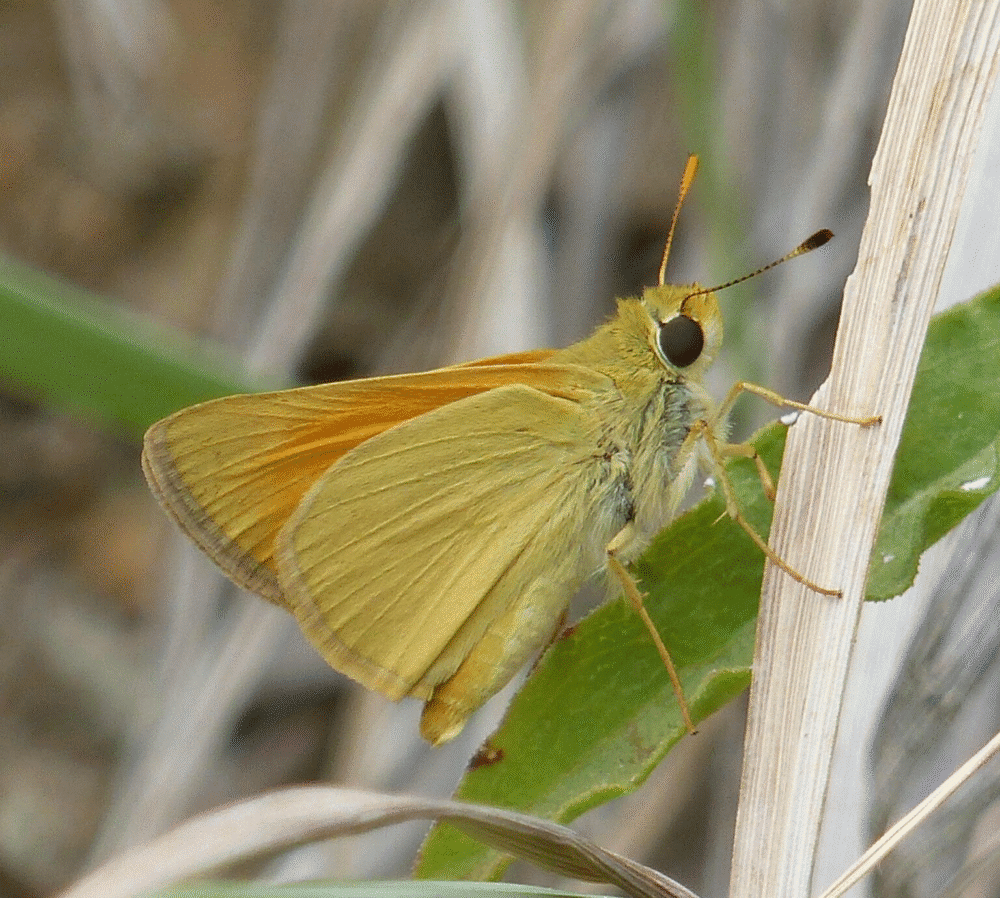
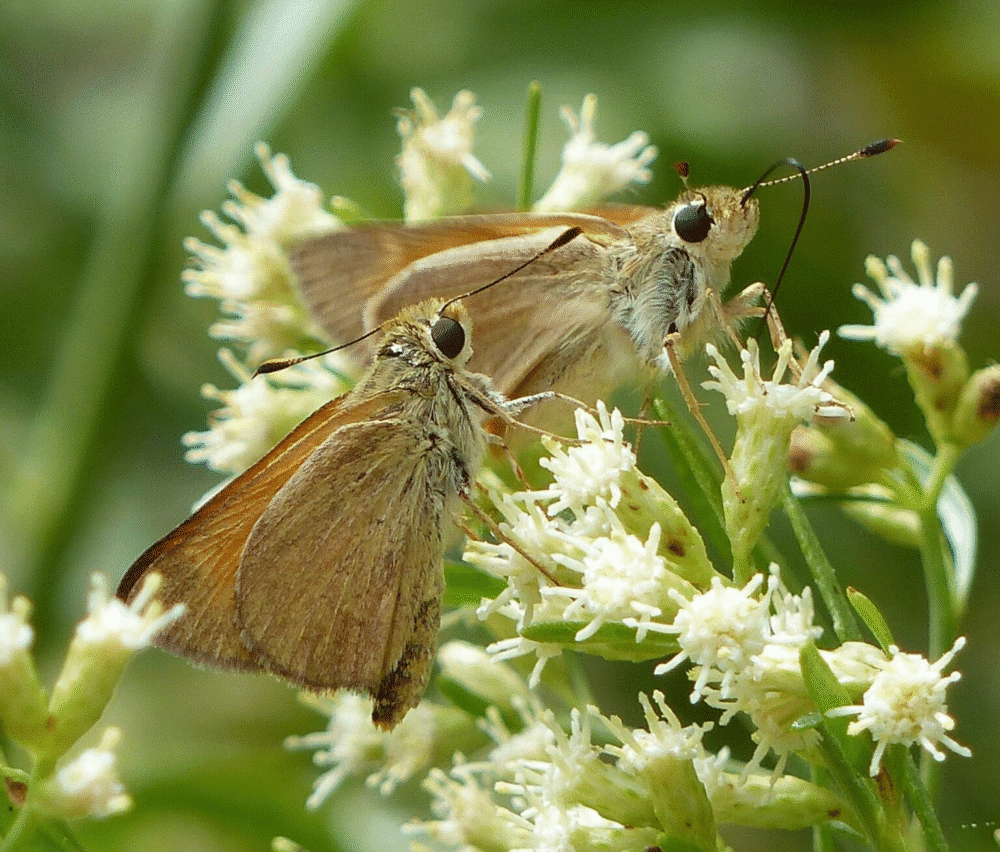
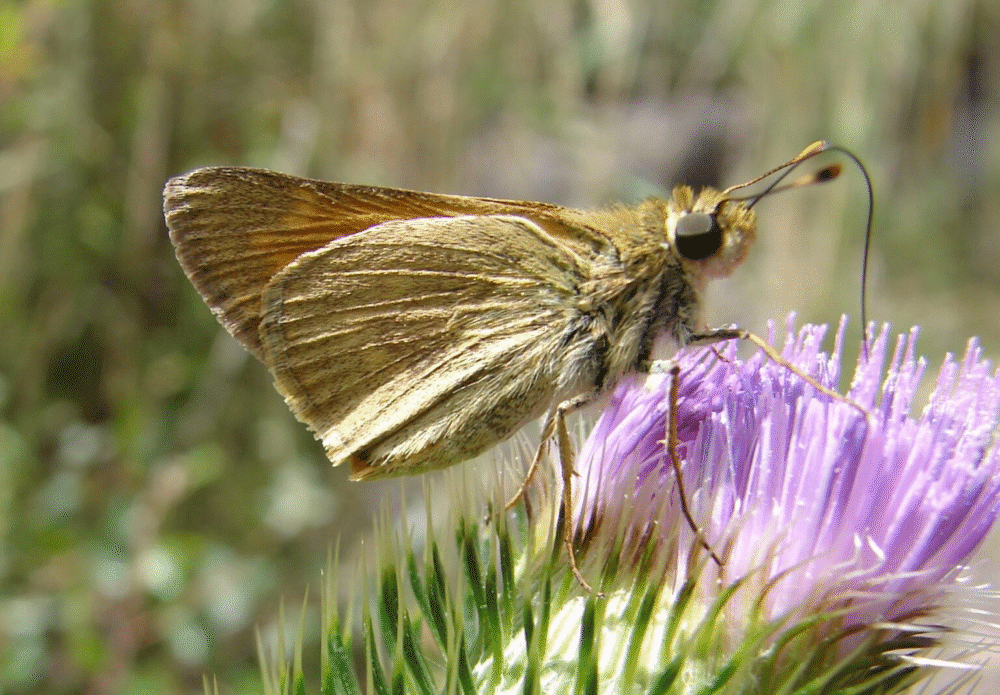
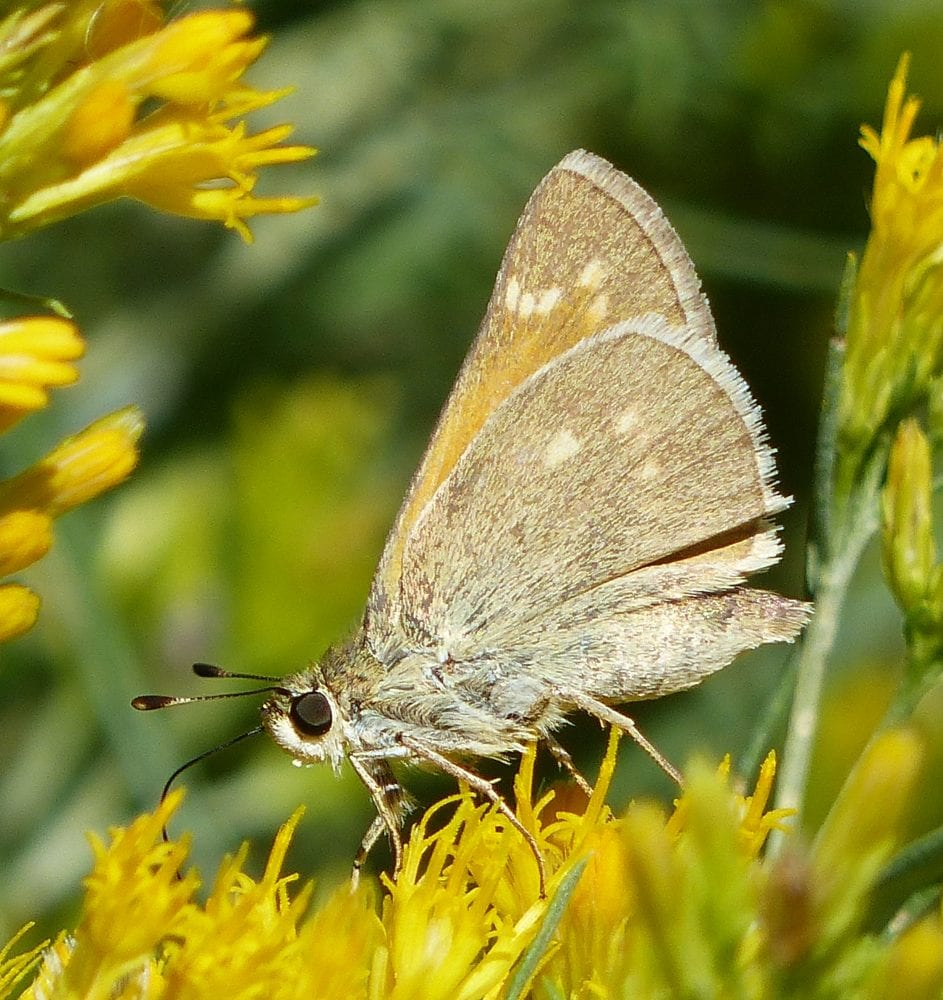

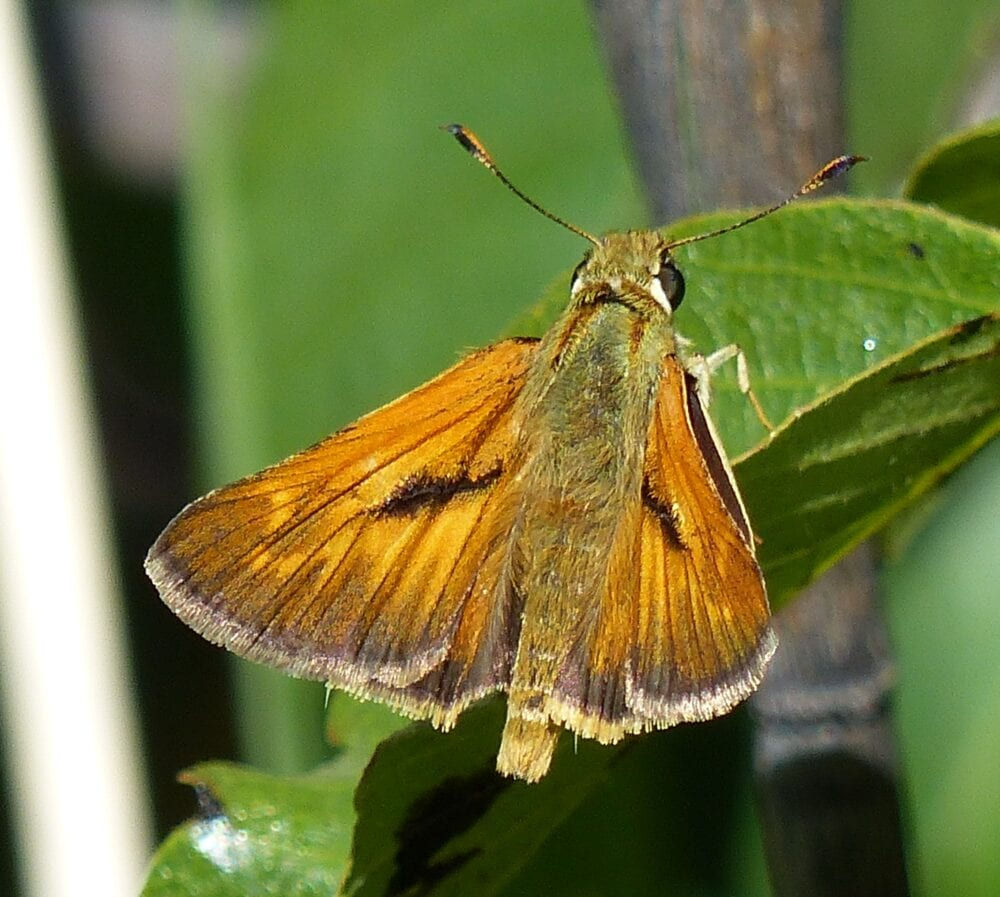

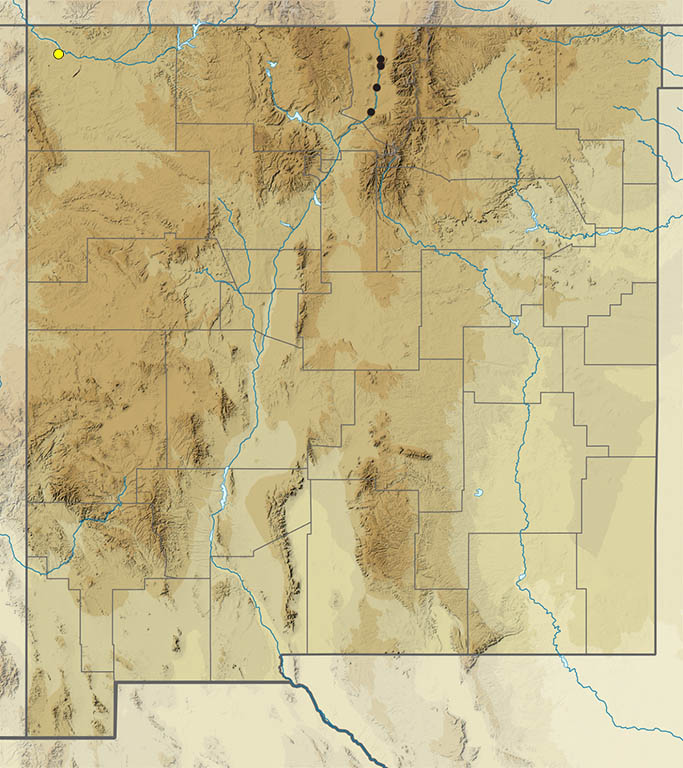
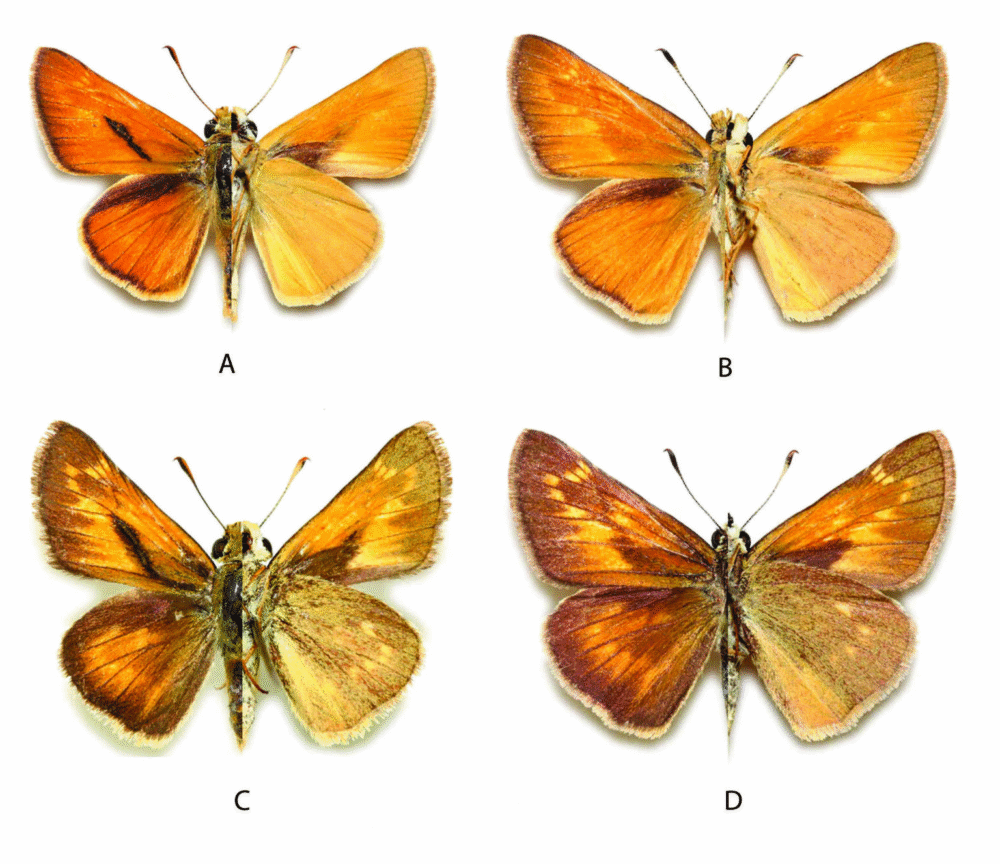
Stinga morrisoni (W. H. Edwards 1878) Morrison’s Skipper (updated June 16, 2024)
Description. With respect to size, shape and general appearance, Morrison’s Skipper resembles the various Hesperia species, but the ventral hindwing has a distinctive long, white, dagger-shaped streak running from the base to the median area. Range and Habitat. Stinga morrisoni frequents Transition and Upper Sonoran Zone grasslands and savannas, from 5400 to 9200′ elevation. It is distributed from Colorado south to Arizona, west Texas and Mexico, including much of New Mexico (counties: Ca,Ch,Ci,Co,Ed,Gr,Li,LA,Lu,MK,Mo,Ot,RA,Sv,SJ,SM,Si,So,Ta,To). Life History. Scott (1992) found that Stipa scribneri (Poaceae) is a larval host in the Rocky Mountain Front Range. Butterflies of America (https://www.butterfliesofamerica.com/t/Stinga_morrisoni_a.htm) has photos of a female ovipositing on Muhlenbergia montana and photos of larval nests and larvae on the same plant in Apache County, AZ. Other grasses (Poaceae) are suspected elsewhere. Mature larvae make grass tubes for overwintering. Flight. Stinga morrisoni is univoltine with adults on the wing in spring. Along our southern tier of counties, the adult flight interval reaches its maximum in April. Look for it in May elsewhere in the state. Extreme flight dates are March 20 and July 3. Males are persistent hilltoppers; both sexes will come to nectar (e.g., Glandularia) and water. Comments. Its hilltopping habits sometimes convey it to summits far above its breeding habitat, such as on Sierra Blanca at 11,997′ (Li). Its name honors H. K. Morrison, a frontier lepidopterist in the Southwest.

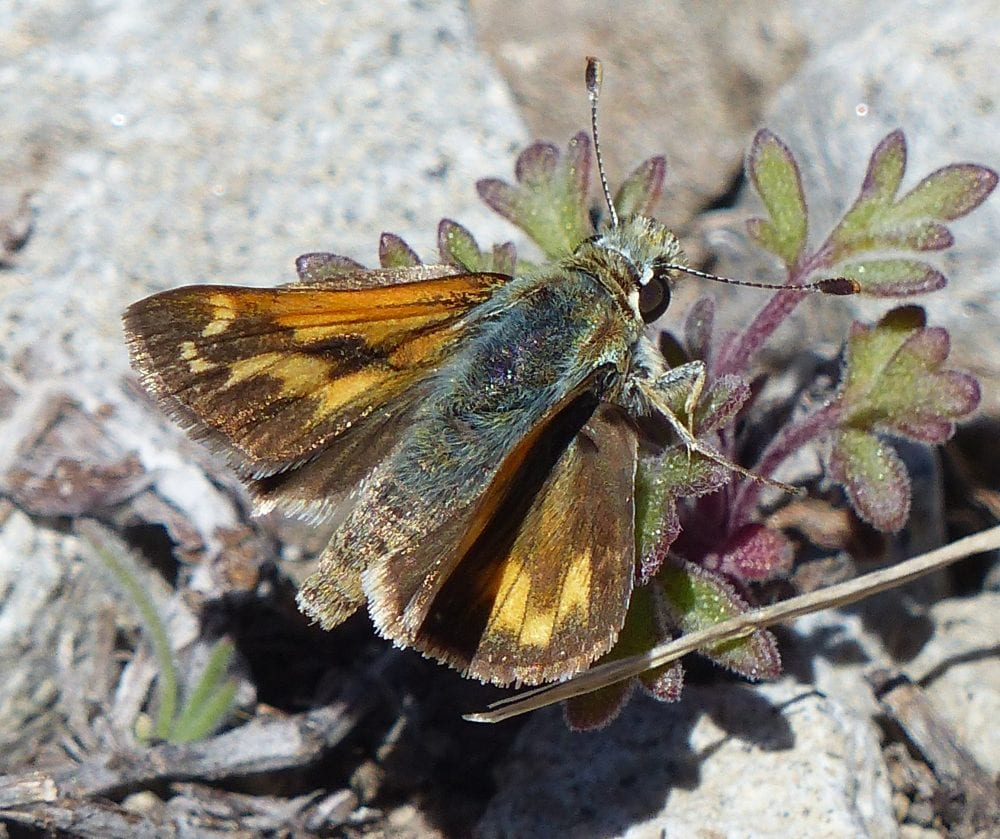

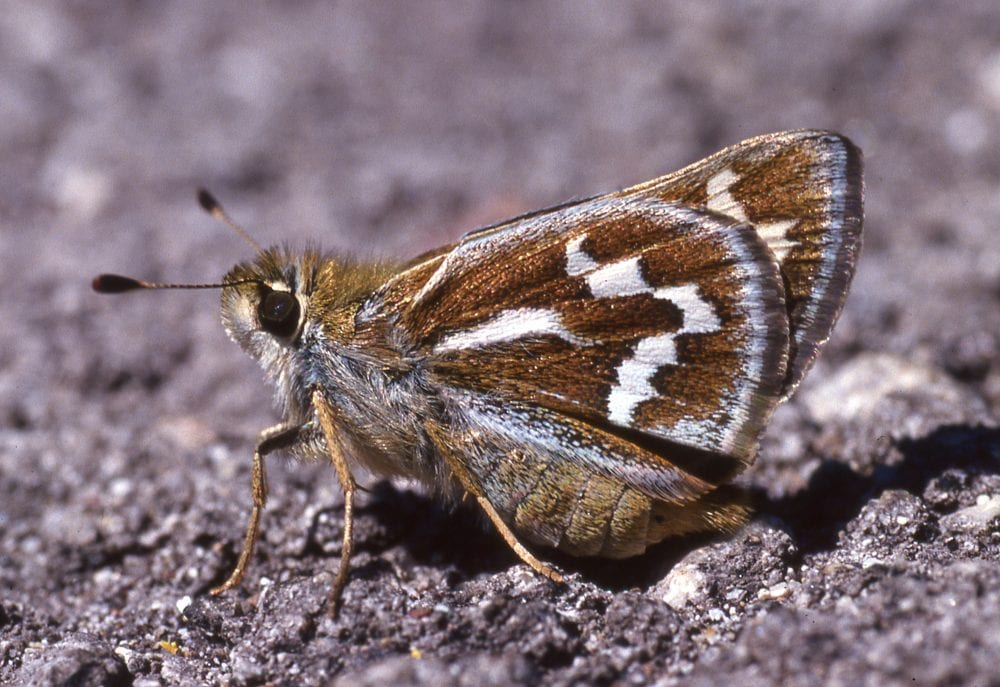

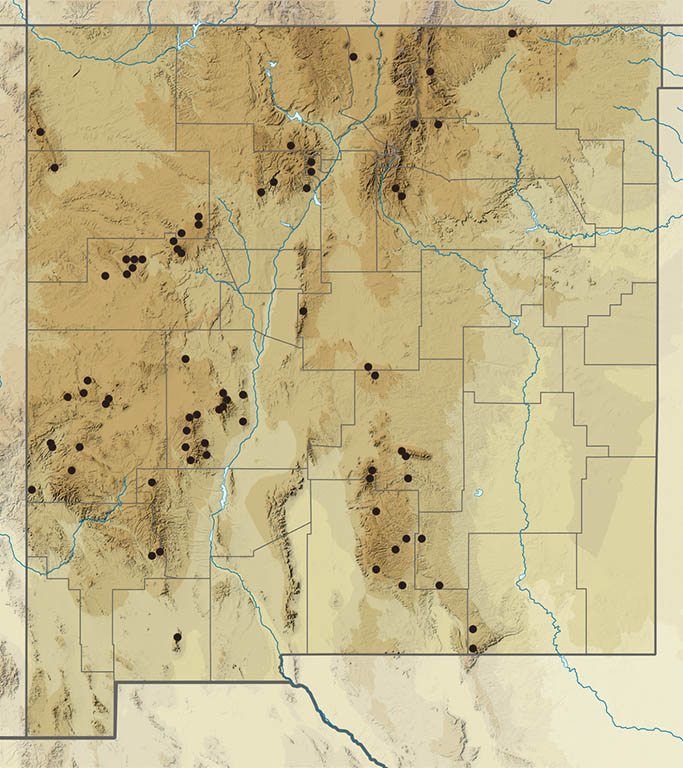
Lon hobomok (T. Harris 1862) Hobomok Skipper (updated February 18, 2023)
Description. Hobomok Skipper is similar to Taxiles Skipper in appearance and habits. When fresh from the chrysalis, Hobomok males are lovely blue and gold underneath. The median spots on the underside of the HW are larger and more blocky in Hobomok than Taxiles. Dark-scaled veins on the dorsum are lacking on Taxiles males. Lon hobomok females are more distinctly gold above than Lon taxiles females. Range and Habitat. Hobomok is prevalent in the rough triangle between Nova Scotia, Saskatchewan and Georgia. Outlier populations are scattered from western North Dakota south to eastern New Mexico (counties: Co,Li,Ot,So,Un) in montane or foothill habitats. They occupy drainages in Transition Zone woodlands, 7500 to 8500′ elevation, often sharing that habitat with Taxiles, whose flight sequence begins about a month after Hobomok’s. Life History. Hosts elsewhere are Panicum and Poa species. (Poaceae). Flight. Hobomok is univoltine, flying from May 12 to July 5, mostly in June. From perches on vegetation near stream banks, males patrol up- and down-drainage looking for females, often returning to the same perch. Females seem a tad reclusive. Both sexes sip nectar and moisture from mud. Comments. James A. Scott first saw this skipper in New Mexico at Raton Mesa (Co) on 4 June 1973. Our populations are best referred to subspecies Lon hobomok wetona J. Scott 1981, which is smaller and lighter than the eastern form. Our other Hobomok populations were discovered by Neil Dankert in the Capitan Mountains (Li) and San Mateo Mountains (So) in 1995. Hobomok Skipper was recently moved from the genus Poanes (Pelham 2019).

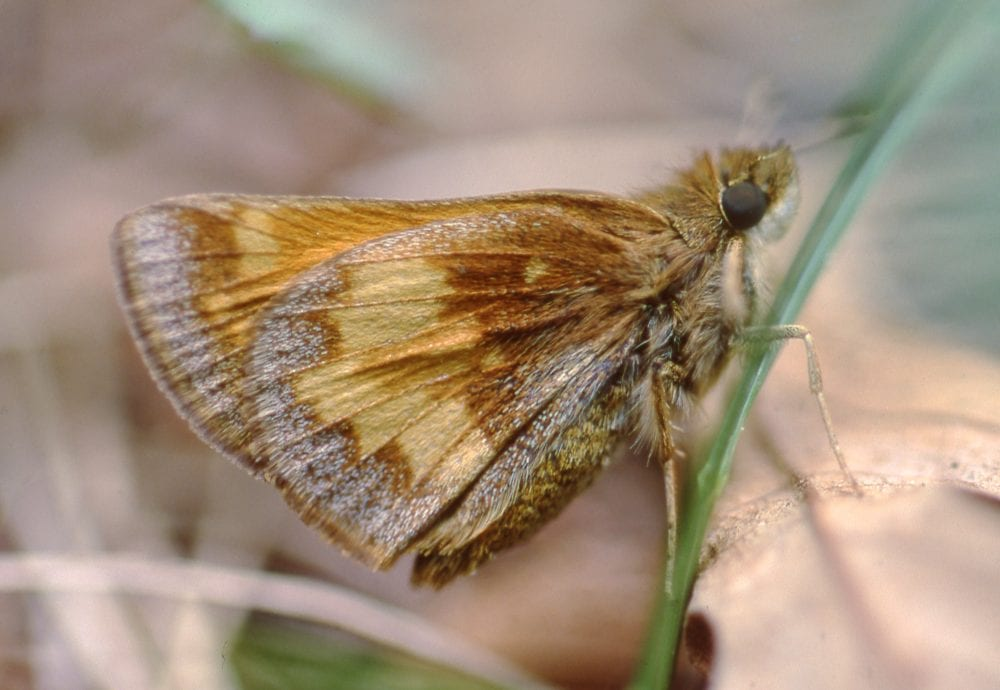


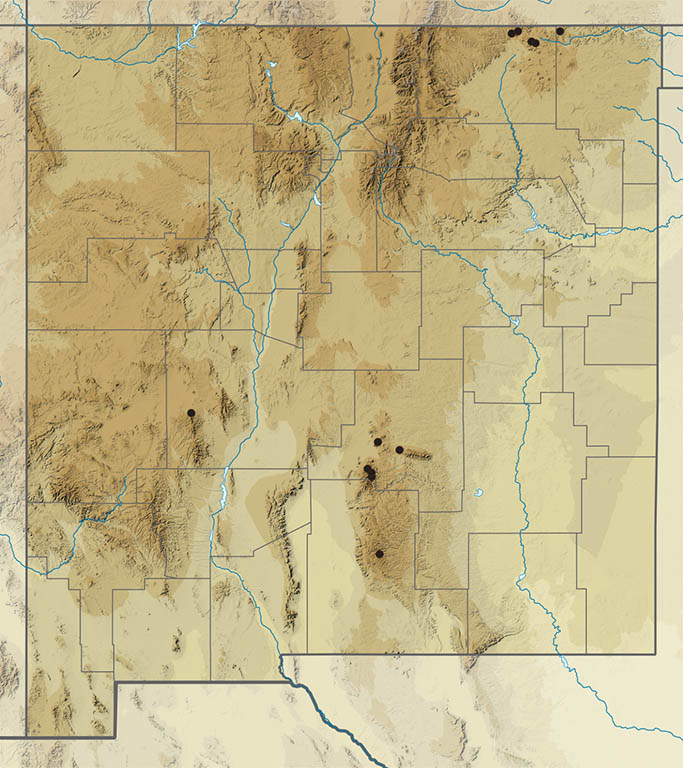
Lon taxiles (W.H. Edwards 1881) Taxiles Skipper (updated February 20, 2023)
Description. Lon taxiles is quite sexually dimorphic. Males are gold above with narrow dark borders and gold below with irregular borders and dark ventral hindwing bases. Females have broad dark margins and dark wing bases above. Female Taxiles are purple-brown below with median gold patches. Male Taxiles may be distinguished from Hobomok by the lack of dark veins in the gold patches on the dorsal surface, particularly on the hind wing, and by the lesser contrast between the “anchor” pattern of postmedian spots on the ventral hind wing. Females are more problematic, but Taxiles females usually have a very thin white edge on the leading edge of the ventral hind wing. Zabulon males lack an obvious “anchor” on the ventral hind wing, and female Zabulon have a much more obvious white leading edge on the ventral hind wing. Range and Habitat. Taxiles Skipper occurs through the Rocky Mountains from Idaho, Wyoming and South Dakota south to the Mexican Sierra Madre and the higher mountains of west Texas. In New Mexico it inhabits Transition Zone riparian areas, generally 7,000 to 9,000′ elevation (counties: Be,Ca,Ci,Co,DA,Gr,Li,LA,MK,Mo,Ot,RA,Sv,SJ,SM,SF,Si,So,Ta,To,Un). Life History. Scott (1992) reported oviposition on 23 different grasses (Poaceae) and concluded that Lon taxiles will utilize any of a variety of tall, single-stem, broadleaf grasses and some bunchgrasses. Flight. Taxiles is univoltine in New Mexico. Records begin June 8, peak in July, and conclude on August 29. Adults patrol streamside habitats, perch with wings half open, nectar at meadow flowers, and extract moisture from moist sand on hot July days. Comments. Scott (1986) argued that Lon taxiles and eastern Lon zabulon (Boisduval & LeConte [1837]) were conspecific. Three specimens of Lon zabulon collected by F. H. Snow are attributed to New Mexico. He reported zabulon from his 1882 collections near Las Vegas, but a specimen in the Snow Entomological Museum bears a label typical for butterflies collected in 1884, when he rode the train from Kansas to Silver City, NM. If actually collected here by Snow, which is debatable, they may have been imported as immatures in livestock feed, perhaps even on the train. There have been no subsequent reports and Lon zabulon does not currently occur in New Mexico as far as we know.
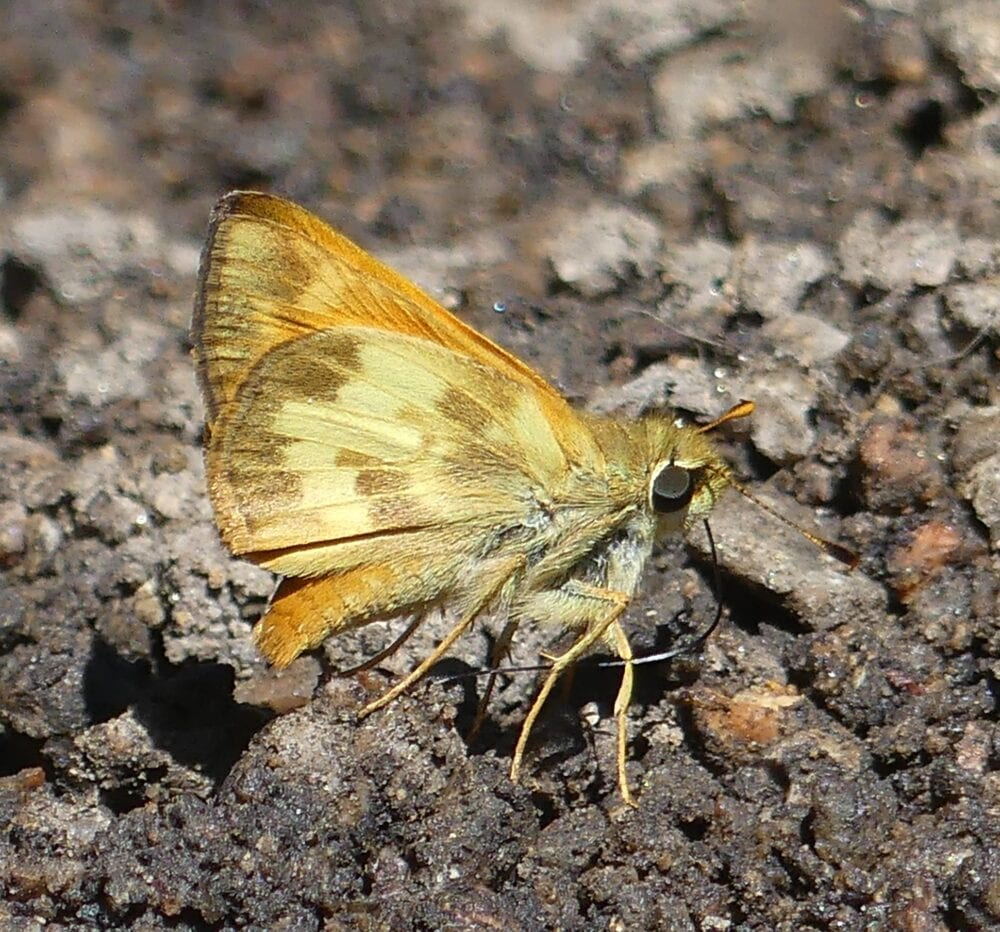


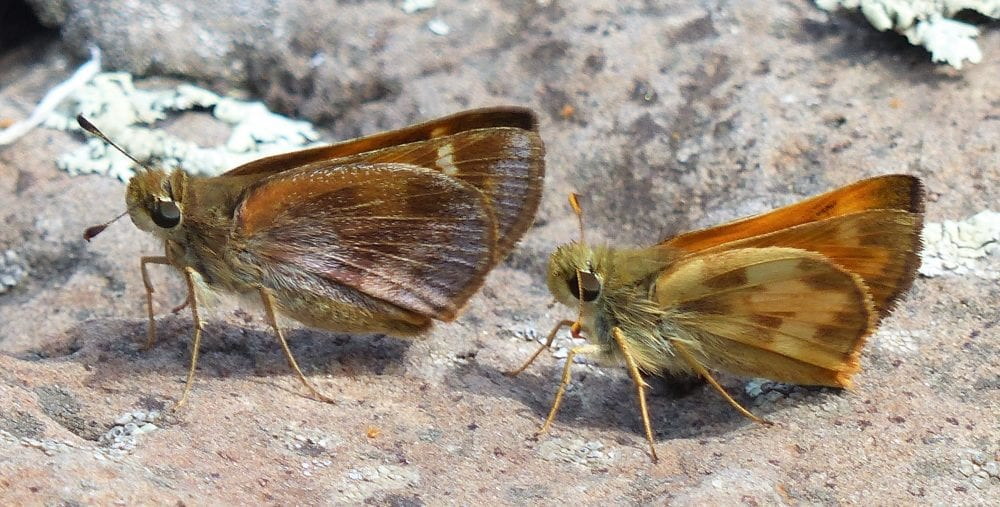
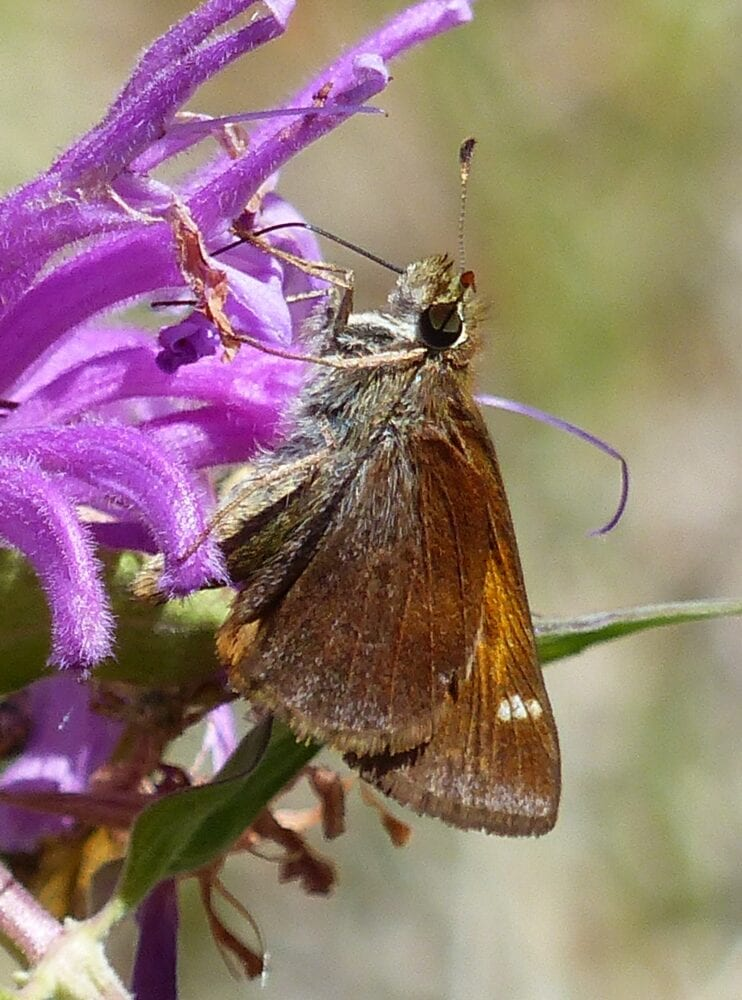


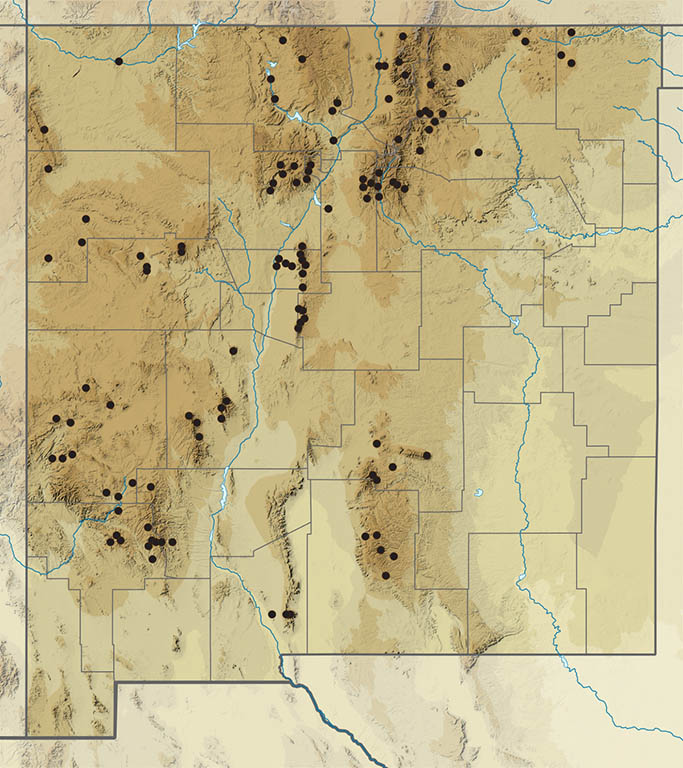
Lon zabulon (Boisduval & LeConte [1837]) Zabulon Skipper (added February 20, 2023)
Description. Zabulon is very similar to Taxiles and Hobomok. Key features to look for are: Zabulon has a slightly more pointed front wing in both sexes. Males have extensive brown at the ventral base enclosing a yellow spot and the “anchor” spot band is absent; the dorsal hind wing gold patch lacks black veins. Females have a prominent white margin at the upper angle of the ventral hind wing. Range and Habitat. This is primarily an eastern butterfly, ranging from the east coast to Kansas and from Iowa, Michigan and Illinois south to Texas, the Gulf Coast and Florida. It is also found in Mexico south to Panama, including Sonora and the Mexican west coast. There are old records from New Mexico, from Las Vegas Hot Springs (SM) or Walnut Creek (Gr). Life History. Larvae feed on a variety of grasses, tying leaves together in typical “skipper fashion.” Males purse other insects (looking for females) by perching on vegetation above the ground (usually about 1-3 m.), unlike Taxiles or Hobomok, which are less territorial. Flight. Our specimens were supposedly taken in July – August. In Sonora, Zabulon appears a month after Taxiles in the same general location (Jim Brock, pers. com.). Comments. Three specimens of Lon zabulon collected by F. H. Snow are attributed to New Mexico, collected in 1882 (Cary and Holland 2002). If actually collected here by Snow (and they may have been collected in Grant County in 1884), they may have been imported as immatures in livestock feed. There have been no subsequent reports of Zabulon in New Mexico as far as we know.
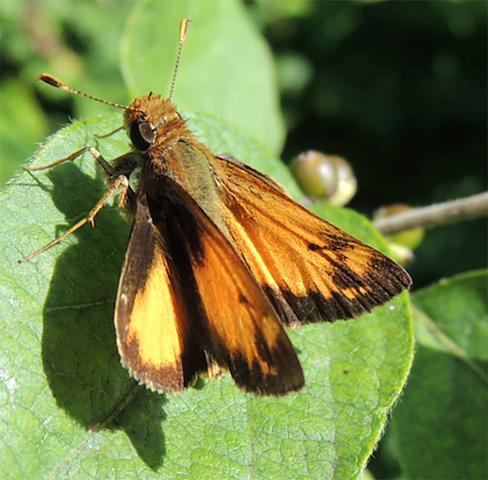
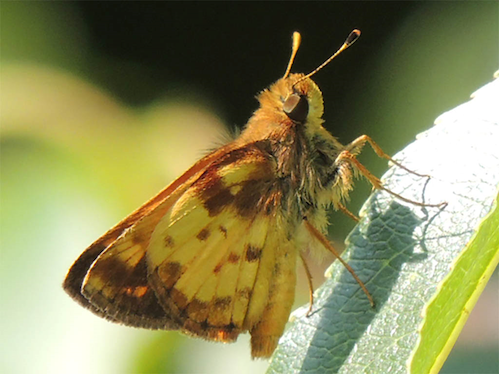
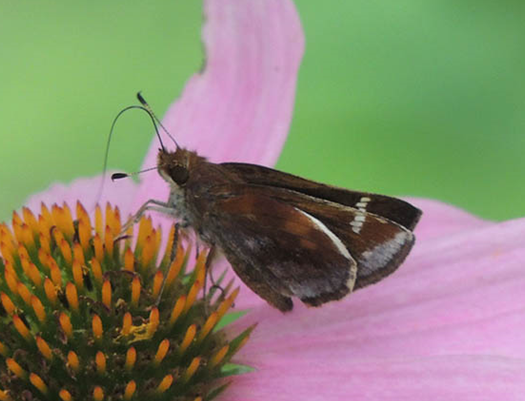
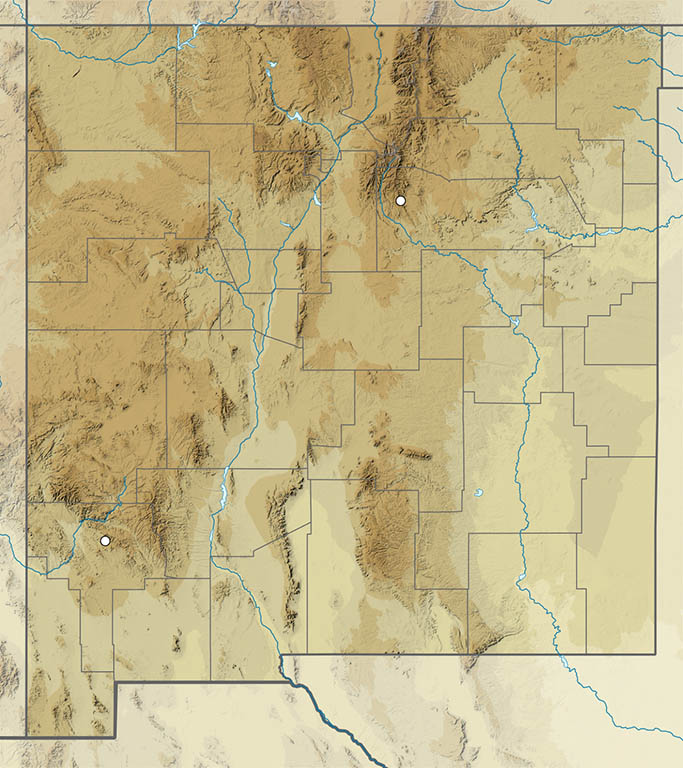
Lon melane (W. H. Edwards 1869) Umber Skipper (updated January 25, 2023)
Description. Its elongated forewings make Umber Skipper our largest and darkest member of the Lon genus, but it is rarely encountered in New Mexico. Both sexes have the purple-brown ventral colors of Taxiles females, with faint pale spots. They are dark brown above with creamy spots. Range and Habitat. Umber Skipper is a Mexican species that reaches its northern limits in California (where it is an urban weed), Arizona, Texas and southwest New Mexico. Our few reports are from piñon-juniper woodlands, about 6500′ elevation, in the Animas Mountains (county: Hi). Those reports suggest that strays may establish ephemeral, peripheral colonies there. Life History. Larval hosts for this skipper include grasses (Poaceae) and a sedge (Cyperaceae) (Scott 1986). Flight. Specific New Mexico records are 22 May, 23 May and 6 September (all 1992), suggesting two broods per year where they breed. Adults were found in canyons. Comments. Our population belongs to subspecies Lon melane vitellina (Herrich-Schäffer), which is darker above than other subspecies. Umber Skipper has been placed by various workers in the genera Poanes, Paratrytone and now Lon.
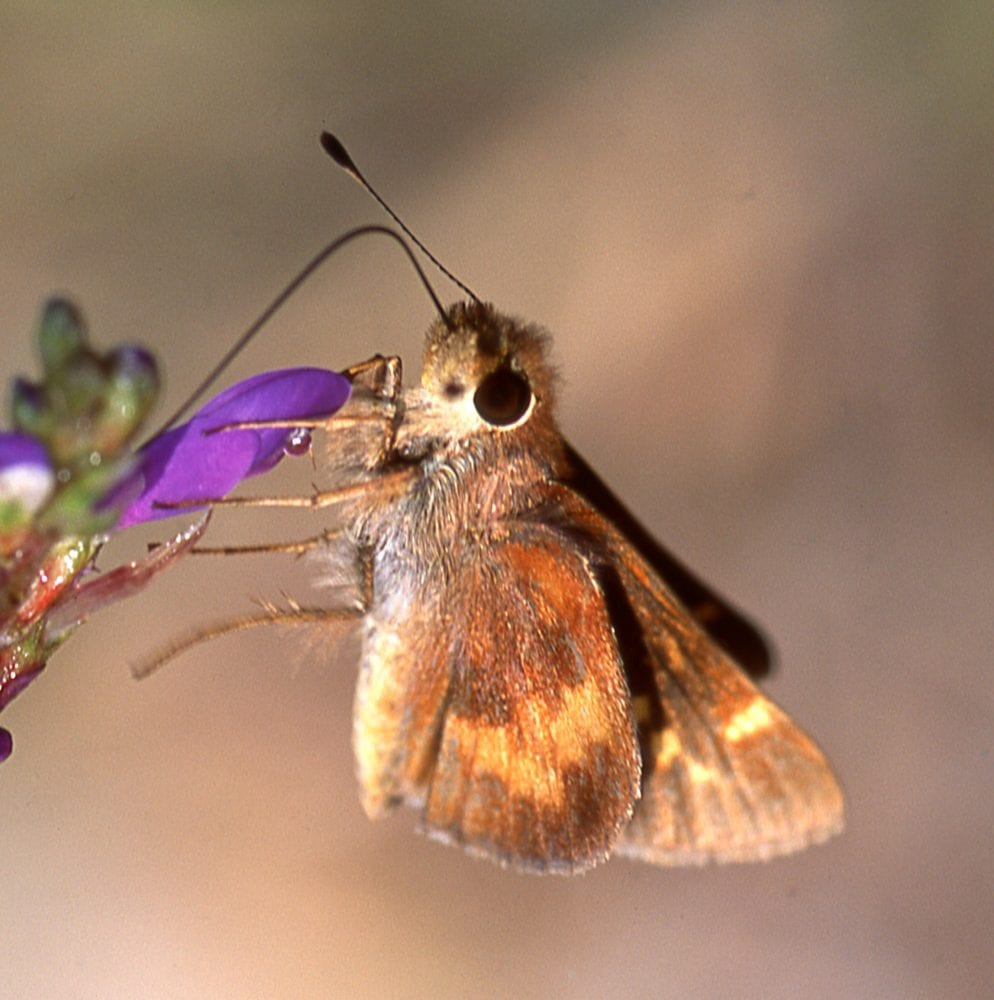

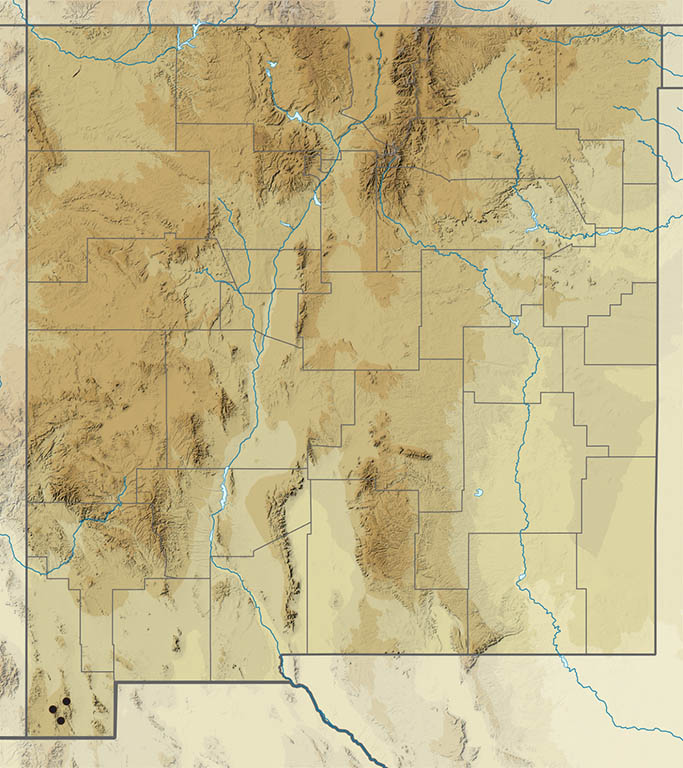
Paratrytone snowi (W. H. Edwards 1877) Snow’s Skipper (updated October 13, 2025)
Description. Snow’s Skipper is of medium-size, dark brown above and unique rusty red-brown below. Males have a prominent medial FW stigma. Cream colored spots occur above and below, with an hourglass-shaped spot in the dorsal forewing cell and a dorsal hindwing median spot. These spots are smaller in males. Range and Habitat. Coppery Paratrytone snowi is a Rocky Mountain butterfly distributed from southeast Wyoming south through Colorado, New Mexico, Arizona and into Mexico along the Sierra Madre Occidental. In New Mexico it is regularly seen in Transition Zone savannas, usually 7000 – 9800′ elevation. It inhabits all our major mountain ranges (counties: Ca,Ci,Co,Gr,LA,MK,Mo,RA,Sv,SM,SF,Si,So,Ta,To). It remains unreported from the SE and SW mountains (Capitans, Sacramentos, Guadalupes, San Andres, San Mateos, and ranges in Luna and Hidalgo counties and, surprisingly, the Sandias. Life History. Blepharoneuron tricholepis is a larval host grass (Poaceae) in southern Colorado. Muhlenbergia montana is another possibility here. Flight. Snow’s Skipper is univoltine, flying between July 6 and August 28. It is usually found along dry gulches and creek edges, nectaring at pink and purple flowers in the understory of open ponderosa pine woodlands. Mike Toliver often found it visiting cold damp, campfire ashes. Comments. William Henry Edwards named it for Professor Francis Huntington Snow, the pioneering University of Kansas entomologist who made important collections in the frontier West, including New Mexico, in the late 1800s. Long considered to be one of the Ochlodes species, Burns (1992) moved Snow’s Skipper to the genus Paratrytone.





Atrytonopsis hianna (Scudder 1868) Dusted Skipper (updated October 13, 2025)
Description. Like all eight of our Atrytonopsis species, Dusted Skipper is of medium size with elongated forewings, gray-brown ground color, and white marks above. Dusted most closely resembles Deva Skipper, but the ranges of these two do not overlap. Dusted is also easily confused with Viereck’s Skipper, but lacks the hourglass-shaped spot at the end of the FW cell of the latter. Other helpful identifying features include a prominent, small stigma in the male, a rounded hindwing and a nearly immaculate ventral hindwing dusted blue-gold when fresh from the chrysalis. There may be a faint postmedian row of dark marks on the hindwing below. Range and Habitat. Atrytonopsis hianna is our only ‘eastern’ Atrytonopsis. There are a few isolated populations in the western High Plains, including northern New Mexico (counties: Co,LA,Sv,Un). Dusted Skipper inhabits mesic prairies and valley bottoms, 6000 to 8600’ elevation. Life History. Our colonies have larvae that eat bluestem grasses: Andropogon gerardii and Andropogon scoparius (Poaceae). Mature larvae overwinter. Flight. Dusted Skippers are univoltine in New Mexico with adults in flight between May 15 and June 30. Adults perch and nectar (e.g., iris, thistle) in gully bottoms and swales near stands of the host grasses. Comments. This Great Plains butterfly has its southwestern-most outpost on Burnt Mesa in Bandelier National Monument (LA,Sv). It was first reported from NM (Frijoles Canyon) by Carl Cushing, a Los Alamos lepidopterist. His report was discounted until other colonies were located nearby in 1984. Our populations belong to subspecies Atrytonopsis hianna turneri H. Freeman 1848.



Atrytonopsis deva (W. H. Edwards 1877) Deva Skipper (updated October 13, 2025)
Description. Deva Skipper can be separated from other Atrytonopsis species, but it requires a view of the right parts. The chief difference is that the dorsal forewing is less marked with white. Compared to the very similar Atrytonopsis vierecki, with which it may fly, the white spots are small and there is no white spot in the dorsal forewing cell. That sounds simple enough to look for, but views of the dorsal forewing are not always offered. Range and Habitat. With the exception of Dusted Skipper, all our Atrytonopsis species occupy limited geographic ranges in the Southwest. Deva has a restricted distribution from the Mogollon Rim in Arizona and New Mexico (counties: Ca,Gr,Hi,Li?,Si,So?) south into the northern Sierra Madre of Mexico. In that region it can be common if you know when and where to look. In New Mexico it lives in Upper Sonoran Zone piñon-juniper-oak savanna habitats in desert mountains and foothills, 4500 to 8200′ elevation. Life History. Grasses (Poaceae) are the likely larval hostplants. Flight. Adult flight records in New Mexico span April 16 to July 6, indicating one annual generation peaking in May. Later summer reports probably refer to the similar Atrytonopsis lunus. Adults perch and nectar in drainages. Comments. Our first report was by P. R. Gleason, who collected it near Central (Gr) on 1 June 1938; this specimen is in the US National Museum. Scott (1986) suggested that Deva may be a southwestern subspecies of Atrytonopsis hianna.





Atrytonopsis lunus (W. H. Edwards 1884) Moon-marked Skipper (updated October 13, 2025)
Description. Moon-marked Skipper has a very dark ground color, darker than all other NM Atrytonopsis. The white hourglass spot in the dorsal forewing cell is more obvious on this species, in large part because of the dark background. A prominent hindwing white fringe is another distinctive feature. Freshly emerged adults have a violet dusting on the ventral hindwing. Range and Habitat. The distribution of this species is slightly more restricted than that of Atrytonopsis deva. In New Mexico, look for it in well-watered, Upper Sonoran Zone canyons (counties: DA,Gr,Hi), 4800 to 7500′ elevation. Life History. Bailowitz and Brock (2021) noted “To date, the larvae have only been found on Muhlenbergia emersleyi. Partially grown larvae overwinter in a tube constructed of leaves in the center of the plant.” This grass is common in southwest New Mexico and probably is a larval host there, too. Flight. This is the only New Mexico Atrytonopsis species that flies in mid-summer and that is a convenient way to identify it. Univoltine adults are on the wing between June 24 and August 29, during the climax of the monsoon season. Reports from earlier in the season are misidentified. Adults are attracted to moist earth and nectar along canyon bottoms. Comments. Our earliest report is from north of Silver City in Grant County, where it was captured by Professor Snow’s group in August 1884. This butterfly remains poorly known in New Mexico.




Atrytonopsis vierecki (Skinner 1902) Viereck’s Skipper (updated October 14, 2025)
Description. Viereck’s Skipper comes with the standard Atrytonopsis package, but with a forewing that is relatively narrow and elongate compared to sister species. The forewing has large translucent white spots, including an hourglass-shaped spot in the cell, which the otherwise similar Deva and Dusted lack. Deva also has a much darker background color. The hoary hindwing below has median bands of variably expressed dark smudges, sometimes accentuated with white dots. The dorsal hindwing is unremarkable gray-brown. Range and Habitat. This is the most widespread of all southwestern Atrytonopsis species. It is known from Utah, Colorado, Arizona, west Texas and most of Upper Sonoran Zone New Mexico (counties: all but Le,Ro,Ta). Its altitudinal range here is mostly 4500 to 7400′, but it has been found as high as 9200′. Life History. Fisher (2017: 176) related James Scott’s 1993 observation that female Viereck’s placed eggs on side-oats grama (Bouteloua curtipendula; Poaceae) in the Colorado Front Range. South of Santa Fe in Cerrillos Hills State Park in June 2022, a female placed an egg on Sporobolus contractus, but subsequent larval feeding was observed only on adjacent bunches of side-oats grama. Flight. Atrytonopsis vierecki is univoltine with adults about in May and June; extreme dates are March 18 and July 4. Later summer reports from SW NM usually prove to be Moon-Marked Skippers. Male Viereck’s perch on gully-bottom rocks and canyon walls, buzz after intruders, and return to their perches. Adults cruise purple nectar, especially thistles. Comments. This species was described from specimens taken by Henry L. Viereck in Dry Canyon, near Alamogordo (Ot), 8 to 13 May 1902. Distinguishing Viereck’s from the similar Deva requires a good view of the upperside or a fortunate glimpse of the ventral FW that exposes the hourglass-shaped cell spot.






Atrytonopsis pittacus (W. H. Edwards 1882) White-Barred Skipper (updated October 14, 2025)
Description. Unlike its sister species, White-Barred Skipper has a distinctive straight, white postmedian stripe on the hindwing upperside and underside. Margarita, Python, and Edwards also have a postmedian spot line but those are not linear. The fringes lack checkering, which the other three with postmedian spots possess. It also has the dorsal forewing white cell spot. Range and Habitat. Atrytonopsis pittacus resides in northern Mexico as well as adjacent Arizona and west Texas. In southwestern New Mexico it favors Upper Sonoran Zone grasslands sprinkled with juniper, oak or piñon, generally 4700 to 7500′ elevation (counties: Ca,DA,Gr,Hi,Lu,Si). Life History. Larval hostplants for White-Barred Skipper remain a mystery, except for multiple reported ovipositions on Bouteloua curtipendula (Side-oats grama; Poaceae) in southeast Arizona (Bailowitz and Brock 2021). That and perhaps other grasses are the likely hostplants here. Flight. Atrytonopsis pittacus completes one brood annually. Peak flight is in April, while extreme dates are March 18 and May 20. Unlike congeners, males establish territories on hilltops rather than in drainages. Adults seek nectar and wet soil. Comments. Our oldest report is a specimen in the Allyn Museum of Entomology, collected by Ms. P. Hoyt at the Catwalk (Ca) on 10 May 1964. A similar skipper, Atrytonopsis cestus (W. H. Edwards, 1884), is known from south-central AZ and west TX and could conceivably be found in NM. It is a rare skipper and easily overlooked. It has the linear spots on the postmedian HW, but the spots are much bigger than the White-barred Skipper. Its fringes are also checkered.




Atrytonopsis margarita (Skinner 1913) Margarita Skipper (updated October 14, 2025)
Description. Margarita Skipper is brightly marked for an Atrytonopsis. The ventral hindwing sports two arcs of whitish spots against a tan background which, on fresh specimens, can be brightly overscaled with light blue. Dorsally, blocky translucent spots in median and post-median areas of the forewing read as white, compared to translucent amber/yellow/gold in the similar Python Skipper. VHW pale spots can be white or yellow and are not diagnostic. Compared with White-Barred Skipper, the dorsal hindwing pale spot band is bent and may be weakly expressed. Wing fringes are heavily checkered. Range and Habitat. Largely a New Mexico insect, Margarita lives in Upper Sonoran and Transition Zones from north-central New Mexico south into west Texas. Look for it principally from 6000 to 7500 feet in mountain foothills and canyon-mesa country, though it has been found as low 4900 and as high as 9500′ feet (counties: Be,Ca,Ch,Ci,DA,Ed,Gu,Li,LA,MK,Ot,RA,Sv,SF,So,To). Life History. Larval hosts are unidentified grasses (Poaceae), but sideoats grama (Bouteloua curtipendula) is suspected. Flight. Adults have been recorded here between May 4 and August 10, but mostly in May and June. Males patrol canyons and arroyos; both sexes come greedily to nectar; hilltopping has been occasionally noted. Comments. Margarita and Python have a taxonomic history befitting their phenotypic similarities. Margarita was initially described as a full species by Henry Skinner in 1913 from specimens collected in the Jemez Mountains (Sv) by John Woodgate. It then spent most of the 20th Century downgraded as a form or variety of Python. Burns (2015) used genitalic characters to separate them once again and re-elevate Margarita to a full species. Python and Margarita also share similar flight period and similar habitats, essentially replacing each other geographically.





Atrytonopsis python (W. H. Edwards 1882) Python Skipper (updated October 14, 2025)
Description. Python Skipper is brightly marked for an Atrytonopsis and closely resembles Margarbita Skipper. Blocky translucent median spots on the forewing (dorsal and ventral) are distinctively tinged with yellow or gold, especially around the edges, in contrast with white (not yellowed) postmedian spots on Margarita. The ventral hindwing is heavily patterned with two arcs of pale spots against a tan background which, on fresh specimens, can be overscaled with blue. VHW pale spots can be white or yellow and thus are not diagnostic. Compared to that of White-Barred Skipper, the dorsal hindwing pale spot band is bent and may be weakly expressed. Wing fringes are heavily checkered. Range and Habitat. Python inhabits Upper Sonoran and Transition Zones in southwestern New Mexico, thence west and south into Arizona and Mexico. In our state, look for it from 5500 to 8000′ elevation in mountain foothills and canyon-mesa country (counties: Ca,Gr,Hi,Lu,Si,So). Life History. Larval hosts are unidentified grasses (Poaceae), but sideoats grama (Bouteloua curtipendula) is suspected. Flight. Adults fly here between May 3 and July 12, peaking in late May. Males patrol canyons and arroyos; both sexes come greedily to nectar. Comments. For nearly a century, Python and Margarita were thought to be conspecific. When Burns (2015) demonstrated they had different genitalia, it also became evident they had subtle phenotypic differences (pale yellow spots v. white spots). Since then, we have been working to disentangle old records. Nick Grishin used genomic data to effectively divide Richard Holland’s 100+ specimens into python and margarita, thus making distribution maps possible for these two look-alike species.





Atrytonopsis edwardsi W. Barnes & McDunnough 1916 Sheep Skipper (updated October 14, 2025)
Description. Sheep Skipper resembles Python Skipper, but the hindwing is more rounded, and the forewing is less elongate, making for a boxier creature. The postmedian band of spots is convex in Sheep, but concave in Margarita and Python. The dorsal hindwing usually has a post-basal white spot which is absent in Margarita and Python. Wing fringes are checked. Range and Habitat. Atrytonopsis edwardsi has a limited distribution in the Mexican Sierra Madre and the Sierra del Carmen, barely reaching into southeast Arizona, southwest Texas and southwest New Mexico (counties: Hi). Here it is a denizen of in Upper Sonoran Zone canyons, 4500 to 5000′ elevation. Life History. In southeast Arizona, larvae are known to eat Bouteloua curtipendula, Cynodon dactylon and Disakisperma dubium (Bailowitz and Brock 2022). Flight. There are three New Mexico records of Sheep Skipper, all from Guadalupe Canyon from September 3 to 8. It is bivoltine elsewhere, with a spring flight in April – June. Adults perch head-down on canyon walls, out of reach of net and camera. They also come to moist earth. Comments. More exploration in New Mexico’s infrequently butterflied Bootheel could demonstrate that this lovely skipper has a greater presence than existing data suggest.


